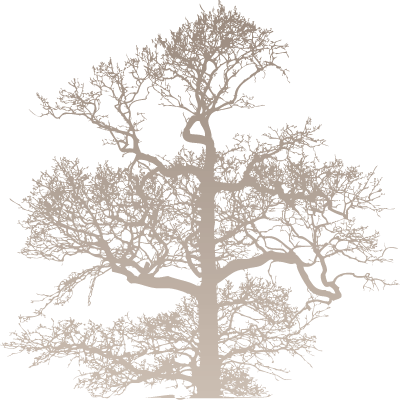| |
Byzantine Catholic
Trenton, Mercer County, New Jersey
Mahwah, Bergen County, New Jersey
Newark, Essex County, New Jersey
Bayonne, Hudson County, New Jersey
New Brunswick, Middlesex County, New Jersey
Hillsborough, Somerset County, New Jersey
Jersey City, Hudson County, New Jersey
Passaic, Passaic County, New Jersey
Perth Amboy, Middlesex County, New Jersey
Perth Amboy, Middlesex County, New Jersey
Phillipsburg, Warren County, New Jersey
Orthodox
Alpha, Warren County, New Jersey
Passaic, Passaic County, New Jersey
Perth Amboy, Middlesex County, New Jersey
Passaic, Passaic County, New Jersey
Byzantine Catholic
Assumption of the Virgin Mary Byzantine Catholic Church
Trenton, Mercer County, New Jersey
TCC wishes to extend a special thank you to Father Gregory J. Noga for offering the history and photos of his parish.
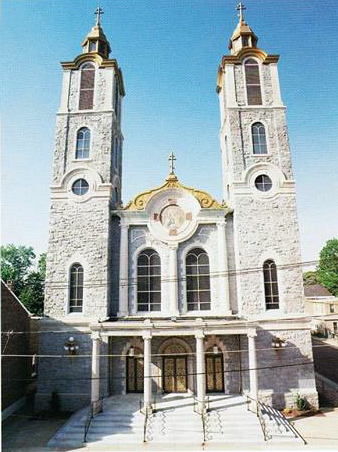
Late in 1889, a group of Carpatho-Rusin people attending the German American Roman Catholic Church in Trenton, New Jersey sought to participate in an occasional Liturgy and to receive the Sacraments according to their own Greek Catholic (now Byzantine) Rite. These pioneers came to America from towns, villages and farms in the part of the Austrian-Hungarian Empire that is now Slovakia and the Ukraine. They brought with them a tremendous capacity for hard work, a strong desire to contribute to their new nation, and above all, a strong love of God. The Reverend Fathers Alexander Dzubay, Gabriel Vislocky and Eugene Volkay, three priests from the vicinity of Wilkes-Barre and Shenandoah, Pennsylvania, were among the first priests of the Byzantine Rite to celebrate the Liturgy and administer the Sacraments to these people.
The actual founding of the church was made by Father Volkay, then pastor at Hazleton, Pennsylvania, with the aid of seven laymen: John Hatrak, John Breza, John Kusnirik, Andrew Bucko, John Ceperak, Michael Skurla, and Michael Breza. On March 15, 1891, these men assembled in the hall of N. Anchak and on the motion of Father Volkay, wholeheartedly agreed to begin their religious life as an organized group. The feast of the Assumption of the Most Pure Virgin Mary was chosen as the patronal feast of the new church. During a Divine Liturgy celebrated by Father Volkay, all present made an initial donation to the new parish. To further unite the group, a benefit society was organized and entrusted with the task of registering fellow Carpatho-Rusins as members of the church.
At the first meeting of the new parish, trustees and ushers were appointed to aid in church work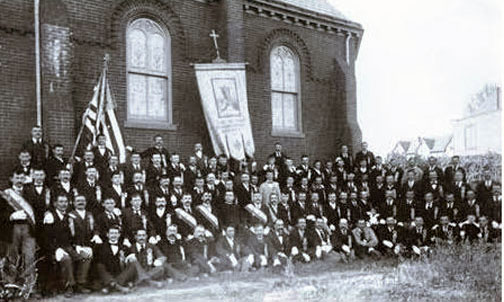 . Space was rented in a new building on the southeast corner of South Broad and Beatty Streets to use as a chapel. (This building later became a dry goods store.) Blessed by Father Volkay in 1891, the chapel contained a small altar, vestments, chalice and other essentials donated by members of the parish. In order to encourage the faithful to regularly attend Sunday services, even if a priest was not always available, a professional teacher and cantor, John Stavrovsky, was hired. Cantor Stavrovsky offered religious instruction, led the faithful in prayer and song, and did much to ensure the growth of the new parish. . Space was rented in a new building on the southeast corner of South Broad and Beatty Streets to use as a chapel. (This building later became a dry goods store.) Blessed by Father Volkay in 1891, the chapel contained a small altar, vestments, chalice and other essentials donated by members of the parish. In order to encourage the faithful to regularly attend Sunday services, even if a priest was not always available, a professional teacher and cantor, John Stavrovsky, was hired. Cantor Stavrovsky offered religious instruction, led the faithful in prayer and song, and did much to ensure the growth of the new parish.
As with any new undertaking, difficulties were encountered and it was a challenge to maintain everyone's commitment to religious observances and spiritual advancement. However, the small religious group persevered with the guidance of the seven loyal and determined organizers. The number of the faithful increased to thirty-two and in a short time, funds were sufficient to send for the Reverend Father John Szabo, who became the first pastor of St. Mary's parish on July 26, 1892. Under Father Szabo's spiritual guidance and leadership, intensive organizational work began.
During the same year, 1892, the construction of a new church was initiated on ground purchased for $1200 on the corner of Grand and Malone Streets. The cornerstone was laid on April 16, 1893 and a brick church with a steeple and bells was erected on a stone foundation. The bells, which cost $500, were blessed on July 30, 1893. Two months later, in September 1893, the church which would accommodate about four hundred people was dedicated with elaborate ceremony by the Most Reverend Michael O'Farrel, D.D. the Bishop of the Roman Catholic Diocese of Trenton assisted by six clergy of the Byzantine Rite. Prior to these later events, the church was incorporated on July 11, 1893 by Bishop O'Farrel. The first Board of Trustees consisted of five individuals: Bishop O'Farrel; Monsignor James A. McFaul, chancellor; Reverend Father John Szabo, pastor; and laymen, John Hatrak and John Breza. As recorded in the minutes of the first meeting, the first by-laws of St. Mary's Greek Catholic Church were formulated and promulgated in accordance with the laws of the State of New Jersey and in compliance with the regulations of the Catholic Church. Thus, under the guidance of Father Szabo, both the legal and spiritual foundations of the new church were secured.
Prior to his reassignment to Punxsutawney, Pennsylvania, Father Szabo recorded the names of parishioners worthy of mention for their zeal and charitable works. The surnames of those individuals were Borsch, Kicinko, Truhan, Scerba, Varga, Artim, Maczovsky, Stopko, Ivan, Vorobjeff, Gocs, and Kostival. On December 10, 1893, Father Theodore Damjanovich became the new pastor and through his efforts and zeal, continued progress was made. In 1894 land for a cemetery was acquired, a fence installed, and a crucifix purchased for $1,000 was erected. The cemetery and crucifix were blessed in June of 1895.
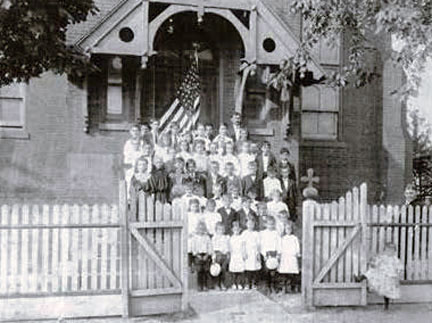 With the continued generosity of the parishioners: liturgical appointments were purchased for the church; paintings in the church initiated by the artist, George Havelka, were completed by Stephen Hegedus; and at the cost of $1300, an Iconostasis was erected. This Iconostasis, subsequently moved to the church of St. Nicholas in Roebling, New Jersey, was blessed in September 1896 by the Most Reverend James A. McFaul, L.L.D., Bishop of the Roman Catholic Diocese of Trenton. Most of the Byzantine clergy of the Eastern United States were in attendance as Bishop McFaul delivered an English sermon and Father Volkay preached the Russian sermon. With the continued generosity of the parishioners: liturgical appointments were purchased for the church; paintings in the church initiated by the artist, George Havelka, were completed by Stephen Hegedus; and at the cost of $1300, an Iconostasis was erected. This Iconostasis, subsequently moved to the church of St. Nicholas in Roebling, New Jersey, was blessed in September 1896 by the Most Reverend James A. McFaul, L.L.D., Bishop of the Roman Catholic Diocese of Trenton. Most of the Byzantine clergy of the Eastern United States were in attendance as Bishop McFaul delivered an English sermon and Father Volkay preached the Russian sermon.
With the completion of the church, Father Demjanovich turned his attention to the building of a school. The school building was constructed and gas and water facilities were installed at a cost of over $7,000. Desks were purchased and John Choma, a professional cantor and teacher, was hired to run the school. Father Demjanovich departed for Europe in October, 1897.
In January 1898, Father John Csurgovich succeeded Father Damjanovich. Although his initial appointment was intended to be a temporary one of six months, Father Csurgovich remained as pastor for seven years. He paid the debt on the cemetery and began construction of a rectory at 210 Grand Street in April, 1899. The rectory was completed and blessed six months later on November 30, 1899. Significant during 1899 was the fire that broke out in the church. Flammable items such as carpets, furniture and tapestries were destroyed but the loss did not exceed $300. In September 1899, the school was officially opened with sixty-seven students. During the early years, about forty students attended school daily and a special course was offered on Saturdays for fifteen children from the surrounding farms. The first teacher of English was Miss Schlotter, and John Choma taught the Rusin language and church chant.
In 1900, the school, church and rectory were equipped with steam heating systems at a cost of $500 and the debt for the rectory was fully paid. The following year, the exterior of both the church and rectory were painted. In addition to the names of parishioners mentioned previously, early accounts of the history of the church recognize the contributions of individuals with the following family names: Jareczka, Smoliga, Baran, Sestak, Smajda, Ceremsak, Ciberey, Andrejco, Bacsik, Francovsky,Ondy, Nagy, Zupko, Novikmec, and Bobera.
On October 2, 1902, the Apostolic Visitor, the Right Reverend Andrew Hodobay celebrated the Divine Liturgy and then blessed several donated religious images and vestments. On May 10, 1903, an official visitation was made by the Most Reverend James A. McFaul, D.D., Bishop of Trenton, who presided at the Solemn Liturgy and also delivered the sermon. The celebration was concluded with a dinner at the rectory. In that same month, Michael Nemeth was appointed cantor of the parish and teacher in the school. Mr. Nemeth was known for his remarkable teaching ability and splendid work in the field of liturgical chant. He organized the youth of the parish and shared a practical knowledge of the Rusin language, singing, reading and writing.
In August 1903, electrical facilities were installed in the church, rectory and school. The balance of the $3000 church mortgage was also paid. This was an important occasion because it marked the first day that the parish had no debt on any of its properties.
While Father Csurgovich was a humble and modest man, he was a zealous pastor and keen administrator who left the parish in sound financial condition. His parting with the church in July 1906 was sadly received by the parishioners. He was succeeded by the Reverend Father Anthony Kecskes from the Diocese of Prjashev, who stayed only for a short time and was succeeded by the Reverend Father Basil Volosin who enjoyed a two year tenure as pastor. Father Volosin was succeeded by the Reverend Father Cornelius Laurisin who worked intensely to assure the progress of the parish. Besides ministering to their spiritual needs, Father Laurisin was instrumental in helping parishioners establish their homes in the vicinity of the church. On his advice, the church purchased nearby property and resold parcels of land at reasonable prices to parishioners who then built their homes there. Thus the vicinity of the church became largely a parishioners' community - for four or five blocks from the church, Grand and Adeline Streets were populated by parishioners. By May 1912, when Father Laurisin was recalled to Europe, the membership of the parish had increased so that the original church was no longer able to accommodate the people. In 1912, ground was also purchased for the second cemetery.
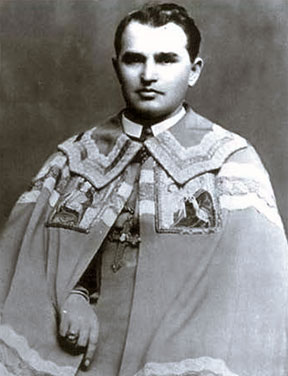 Father Laurisin was succeeded by another zealous and industrious priest, the Reverend Father Joseph Kovalchik. His brief stay of three years witnessed great achievement. The membership of the parish during his pastorate was over 700 families. The magnificent church that stands today was built. A masterpiece of architectural design and artistic skill, the granite church was constructed at a cost of $48,000. In 1941 at the time of the fiftieth anniversary of the parish, the value of the church was "estimated to be not less that $150,000." Father Laurisin was succeeded by another zealous and industrious priest, the Reverend Father Joseph Kovalchik. His brief stay of three years witnessed great achievement. The membership of the parish during his pastorate was over 700 families. The magnificent church that stands today was built. A masterpiece of architectural design and artistic skill, the granite church was constructed at a cost of $48,000. In 1941 at the time of the fiftieth anniversary of the parish, the value of the church was "estimated to be not less that $150,000."
On January 14, 1914, His Excellency, the Most Reverend Soter Ortinsky, D.D. assumed jurisdiction over Byzantine Catholic Churches in America. By virtue of civil law, he acquired the authority of President of the Board of Trustees and St. Mary's Church automatically fell under his jurisdiction. It was by authorization of this Board of Trustees on November 20, 1914, that the first mortgage in the amount of $40,000 was obtained for the construction of the new church building.
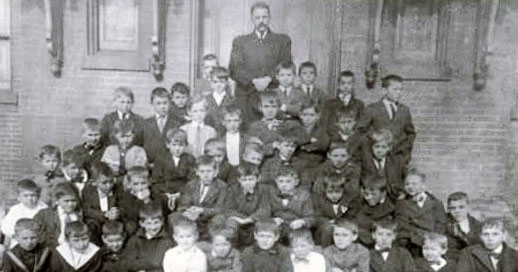 Father Kovalchik was succeeded by the Reverend Father Valentine Balogh who served St. Mary's for only five months. Father Balogh was succeeded by the Reverend Father Eugene Homicsko after whose arrival the new church was dedicated by the Most Reverend Bishop Soter Ortinsky. Father Homicsko had far-reaching plans that required the generous support and cooperation of parishioners. One of his priorities was to build a new school where parish children could be taught in a truly Catholic spirit in accordance with the Byzantine Rite under the guidance of the Sisters of St. Basil the Great. On August 15, 1920, the Board of Trustees adopted a resolution to obtain a loan of $130,000 to construct a school on the site of the first church. This building continues to stand today on the corner of Grand and Malone Streets. Father Kovalchik was succeeded by the Reverend Father Valentine Balogh who served St. Mary's for only five months. Father Balogh was succeeded by the Reverend Father Eugene Homicsko after whose arrival the new church was dedicated by the Most Reverend Bishop Soter Ortinsky. Father Homicsko had far-reaching plans that required the generous support and cooperation of parishioners. One of his priorities was to build a new school where parish children could be taught in a truly Catholic spirit in accordance with the Byzantine Rite under the guidance of the Sisters of St. Basil the Great. On August 15, 1920, the Board of Trustees adopted a resolution to obtain a loan of $130,000 to construct a school on the site of the first church. This building continues to stand today on the corner of Grand and Malone Streets.
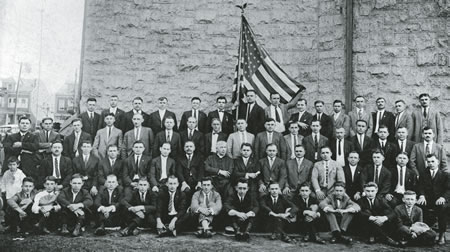 The annual statements of the parish indicate that the total amount spent on the school was $180,000. The bank loan was $135,000 and the balance was borrowed from members of the parish. The school was solemnly dedicated on Thanksgiving Day, November 27, 1922 by His Excellency, the Most Reverend Metropolitan Count Septycki, D.D., who was visiting the United States. In spite of a very promising financial outlook, difficulties arose from the very beginning. To pay the enormous debt, special collections were made and assessments were levied; this led to considerable discord among parishioners. The turmoil was climaxed by the decision to build a new home for the Sisters. This required an additional loan of $30,000. The annual statements of the parish indicate that the total amount spent on the school was $180,000. The bank loan was $135,000 and the balance was borrowed from members of the parish. The school was solemnly dedicated on Thanksgiving Day, November 27, 1922 by His Excellency, the Most Reverend Metropolitan Count Septycki, D.D., who was visiting the United States. In spite of a very promising financial outlook, difficulties arose from the very beginning. To pay the enormous debt, special collections were made and assessments were levied; this led to considerable discord among parishioners. The turmoil was climaxed by the decision to build a new home for the Sisters. This required an additional loan of $30,000.
Father Eugene Homicsko was an industrious pastor who gave his full energy to the tasks he faced. Unfortunately, his health rapidly declined and ultimately forced him to tender his resignation to the Most Reverend Basil Takach, D.D., newly appointed by the Holy See as Bishop for the Carpatho-Rusin Greek Catholics (Byzantine-Ruthenian Catholics) in the United States. Father Homicsko died shortly after his transfer to Beaver Meadows, Pennsylvania and before the completion and dedication of the convent by Bishop Takach who resided in Trenton at the time. Father Homicsko was ultimately succeeded by the Reverend Father Desiderius A. Simcoe, a young, capable and energetic man who arrived in Trenton on September 21, 1928 from a well organized parish in Beaver Meadows, Pennsylvania.
Father Simcoe confronted an enormous task. Morale was low and the financial status and prospects were almost hopeless. Yet he achieved the apparently impossible. Patience, sermons, instructions, frequent contacts with the faithful at all parochial and social activities of the church, reorganization of the Youth Club, and the organization of new societies (Altar Society, Sacred Heart and Sodality) produced fruit. One of his first achievements was the introduction of the envelope system; this increased weekly offerings and helped in registering regular members of the parish. The response was excellent, and the generosity of parishioners restored the church's financial health.
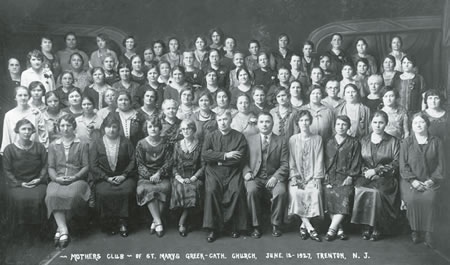 As a result of the dedication and hard work of the Sisters of St. Basil the Great, the school became one of the outstanding elementary schools in Trenton. In 1930, John Mitchell succeeded John Nemes in the role of cantor-and-teacher. Following the difficult years of the 1920's during which church membership declined from 700 families to less than 150 families, the spiritual and social life of the parish regained vitality and many of its former members returned. In 1935, the Girls' (Ladies') Auxiliary was organized as a branch of the St. Mary's Greek Catholic Men's Club and since that time has played a remarkable role in assisting the church in spiritual, social, and fund-raising activities. As a result of the dedication and hard work of the Sisters of St. Basil the Great, the school became one of the outstanding elementary schools in Trenton. In 1930, John Mitchell succeeded John Nemes in the role of cantor-and-teacher. Following the difficult years of the 1920's during which church membership declined from 700 families to less than 150 families, the spiritual and social life of the parish regained vitality and many of its former members returned. In 1935, the Girls' (Ladies') Auxiliary was organized as a branch of the St. Mary's Greek Catholic Men's Club and since that time has played a remarkable role in assisting the church in spiritual, social, and fund-raising activities.
With the return of orderliness in the parish, the people responded generously to the needs of the church. During the Great Depression and with a heavy mortgage at 5 ½ and 6 % interest, both the parishioners and the pastor had to make great sacrifices. Father Simcoe somehow managed to keep the church from bankruptcy on many occasions. He ultimately stabilized its financial status by consolidating debts and paying off a major part of the mortgage.
 During the late 1930's and early 1940's, many improvements to the church and the parish took place without the need to levy special assessments on parishioners. Paintings in the church were restored. The Iconostasis was artistically rebuilt and reinforced. The Holy Sepulcher was dismantled and rebuilt. A sound system was installed, pews refinished, and lighting improved. An artistic, handmade altar and white birch pews were installed in the Sisters' chapel. A new terrazzo floor was installed in the church, the roof of the school was completely replaced, and a sorely needed rectory was built. During the twenty-eight years of Father Simcoe's pastorate, St. Mary's became one of the largest and most outstanding parishes in the diocese - a tribute to a devoted pastor, and committed and generous parishioners. During the late 1930's and early 1940's, many improvements to the church and the parish took place without the need to levy special assessments on parishioners. Paintings in the church were restored. The Iconostasis was artistically rebuilt and reinforced. The Holy Sepulcher was dismantled and rebuilt. A sound system was installed, pews refinished, and lighting improved. An artistic, handmade altar and white birch pews were installed in the Sisters' chapel. A new terrazzo floor was installed in the church, the roof of the school was completely replaced, and a sorely needed rectory was built. During the twenty-eight years of Father Simcoe's pastorate, St. Mary's became one of the largest and most outstanding parishes in the diocese - a tribute to a devoted pastor, and committed and generous parishioners.
The Golden Jubilee of the parish was celebrated on Thanksgiving Day, November 27, 1941 with a Solemn Divine Liturgy of Thanksgiving offered by the Reverend Stephen Gulovich, D.D., Chancellor and personal representative of the Most Reverend Basil Takach, D.D., Bishop of the Greek Catholic Diocese of Pittsburgh. Eighteen priests participated. A banquet in the school hall followed the ceremonies in church. The school children presented a short program and the school band, under the direction of Mr. Joseph F. Mayer, rendered a few selections. Father Volkay, founder of the church, was present along with lay-organizers Mr. and Mrs. Skurla, Mr. and Mrs. John Breza, Ms. Anna Hatrak. These individuals were dispensed from any obligatory support to the Church for the rest of their lives.
After the death of Father Simcoe on June 12, 1956, the Reverend Father George J. Chegin was appointed pastor by the Most Reverend Nicholas T. Elko, D.D., Apostolic Exarch of Pittsburgh. On July 4, 1956, Father Chegin undertook his new pastoral duties with zeal, fervor and diligence. He increased the number of Liturgies on Sunday and Holy Days to accommodate workers and vacationers and, following the tradition of Father Simcoe, continued the various devotions. On February 11, 1957, Father Chegin was appointed Dean of South Jersey and was formally installed on April 25, 1957.
During the next two years, Father Chegin initiated a "Money Raising Campaign" for the purpose of renovating and redecorating the church. The church was completely renovated, the Iconostasis dismantled, the Icons applied to the walls surrounding the altar, and new appointments purchased at a cost of $150,000. In addition, extensive repairs to the school were made at a cost of $50,000 and the ground at the third cemetery, purchased in 1948, was filled in at a cost of $10,000. These projects were paid in full during Father Chegin's pastorate. A Solemn Rededication of the church took place on October 2, 1960.
On July 31, 1963, the Apostolic Delegate to the United States announced the formation of the new diocese of Passaic and the appointment of its first bishop, the Most Reverend Stephen Kocisko, D.D. former auxiliary to the Most Reverend Nicholas T. Elko, D.D. Bishop Kocisko reappointed Father Chegin as Dean of South Jersey on September 10, 1963. The First Canonical Visitation of St. Mary's by Bishop Kocisko took place on May 22, 1964.
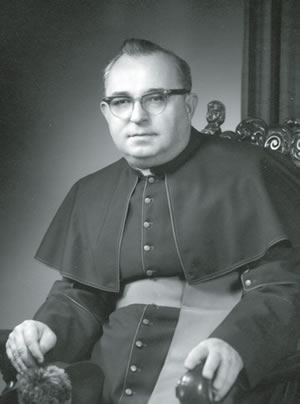 For reasons of health, Father Chegin formally requested that Bishop Kocisko relieve him of his duties. (Father Chegin died on February 14, 1974.) On August 4, 1964, the Right Reverend Msgr. John A. Stim, V.F., former pastor of St. Michael's Cathedral in Passaic, was appointed as the new pastor of St. Mary's and Dean of South Jersey. Many unforeseen difficulties confronted the new pastor. Although the cost of renovating the church and school were paid in full, $100,000 in debt for the mortgage, demand notes, and loans from parishioners still remained. A parish census was conducted. A new roof was installed on the church building at a cost of $15,000 and the ceiling of the sanctuary was repaired. At the cost of an additional $25,000, the school building received a new roof, the school furnace was repaired, and the convent was completely renovated and refurbished. Through the hard work and generosity of the entire parish and the leadership of Msgr. Stim all of this debt was carefully and painfully liquidated. On July 1, 1966, seventy-five years since its inception and sixty-three years since its first resolution of property debt, the parish was again free of any encumbrances. For reasons of health, Father Chegin formally requested that Bishop Kocisko relieve him of his duties. (Father Chegin died on February 14, 1974.) On August 4, 1964, the Right Reverend Msgr. John A. Stim, V.F., former pastor of St. Michael's Cathedral in Passaic, was appointed as the new pastor of St. Mary's and Dean of South Jersey. Many unforeseen difficulties confronted the new pastor. Although the cost of renovating the church and school were paid in full, $100,000 in debt for the mortgage, demand notes, and loans from parishioners still remained. A parish census was conducted. A new roof was installed on the church building at a cost of $15,000 and the ceiling of the sanctuary was repaired. At the cost of an additional $25,000, the school building received a new roof, the school furnace was repaired, and the convent was completely renovated and refurbished. Through the hard work and generosity of the entire parish and the leadership of Msgr. Stim all of this debt was carefully and painfully liquidated. On July 1, 1966, seventy-five years since its inception and sixty-three years since its first resolution of property debt, the parish was again free of any encumbrances.
 Parish work was not completed. For the next two decades, Msgr. Stim focused on upgrading and increasing parish facilities, and maintaining its spiritual, educational and social programs. The year 1971 saw the First Canonical Visitation by the Most Reverend Michael J. Dudick, D.D, Bishop of Passaic. In 1972, a large one-story building, a former A&P food store on the corner of Beatty and Adeline Streets, was purchased and transformed into a spacious and attractive Parish Center at the approximate cost of $300,000. The Solemn Dedication of St. Mary's Parish Center by Bishop Michael Dudick, D.D. took place on September 15, 1974. Today, the Parish Center continues as the home of Wednesday and Sunday bingos, church socials, dinners, and special programs. In 1977, the third cemetery was completed and opened. In 1984, three acres of land with three buildings were purchased on Route 130 North in Robbinsville, New Jersey. The largest of the buildings was transformed into a Chapel that could accommodate over one hundred and thirty worshippers during the Divine Liturgies each Sunday and Holyday of Obligation. The ranch type house on the property was used as a site for religious instruction and as a parish center. The cost of the property and chapel construction was $630,000. Msgr. Stim also purchased a private house on the corner of Adeline and Malone Streets. This property, which abuts those of the rectory and school, originally housed the parish Religious Gift Shop and After-Care Center; today it is used for Eastern Catholic Formation classes. Parish work was not completed. For the next two decades, Msgr. Stim focused on upgrading and increasing parish facilities, and maintaining its spiritual, educational and social programs. The year 1971 saw the First Canonical Visitation by the Most Reverend Michael J. Dudick, D.D, Bishop of Passaic. In 1972, a large one-story building, a former A&P food store on the corner of Beatty and Adeline Streets, was purchased and transformed into a spacious and attractive Parish Center at the approximate cost of $300,000. The Solemn Dedication of St. Mary's Parish Center by Bishop Michael Dudick, D.D. took place on September 15, 1974. Today, the Parish Center continues as the home of Wednesday and Sunday bingos, church socials, dinners, and special programs. In 1977, the third cemetery was completed and opened. In 1984, three acres of land with three buildings were purchased on Route 130 North in Robbinsville, New Jersey. The largest of the buildings was transformed into a Chapel that could accommodate over one hundred and thirty worshippers during the Divine Liturgies each Sunday and Holyday of Obligation. The ranch type house on the property was used as a site for religious instruction and as a parish center. The cost of the property and chapel construction was $630,000. Msgr. Stim also purchased a private house on the corner of Adeline and Malone Streets. This property, which abuts those of the rectory and school, originally housed the parish Religious Gift Shop and After-Care Center; today it is used for Eastern Catholic Formation classes.
After serving the parish for twenty-three years, Msgr. Stim retired in 1987. His immediate replacement was the Reverend Msgr. Alan Borsuk who served as pastor for eleven months prior to his reassignment to St. John the Baptist Church in Bayonne, New Jersey.
Father Borsuk was succeeded by the Reverend Msgr. Nicholas I. Puhak who came to our parish from St. Mary's Church in Manville, New Jersey in June, 1988. As coincidence would have it, Msgr. Puhak is the grandson of the very first pastor, Father John Szabo and also the nephew of another former pastor, Father George Chegin.
Msgr. Puhak continued the role started by his grandfather nearly one hundred years earlier - that of guiding parishioners to better serve God. Much time was also spent on the enormous repairs required in the church building, including forty new blocks of granite, new steel beams and 500 stainless foot-long pins. The exterior was cleaned, new gutters and flashing installed, and the bell towers painted. The interior benefited from improved lighting, a new confessional, refurbished pews, repair of walls, additional marble wainscoting, and painting. The Parish Center received additional air-conditioning and heating units, an acoustical ceiling, new roofing, exhaust system and stucco work. The school building endured asbestos removal, replastering, plumbing and electrical improvements, installation of new smoke detectors and fire alarm systems, and repainting throughout the building. All of this work, at a cost of $725,000 required tremendous financial commitment and support by members of the parish.
Nearly all of the above improvements were completed before the beginning of celebrations in honor of the parish centennial year. In honor of the Centennial, trips were sponsored to the Blue Army Shrine of Our Lady of Fatima in Washington, D.C., to Ellis Island museum where the relatives of many parishioners entered America, and to Las Vegas. On August 13, 14 and 15, 1991 a Tridium was held in honor of the Patroness of the parish. Father Benedict Groeschel, a Franciscan Friar of the Renewal, offered an inspiring homily during this time and Msgr. Ted Wojciehowski of nearby Holy Cross Church preached at the Divine Liturgy. On September 8, 1991 a Divine Liturgy was offered and a Picnic followed at Liberty Lake in Columbus, New Jersey. On October 5th and 6th of the same year, the school children and the choir gave two performances of Carpatho-Rusin religious and folk songs and dances under the direction of Jerry Jumba, musical director of the Diocese of Pittsburgh. Finally, the Centennial celebration concluded with a Divine Liturgy on October 27, 1991 followed by a banquet at the Princeton Marriott Hotel attended by 900 parishioners, guests and friends.
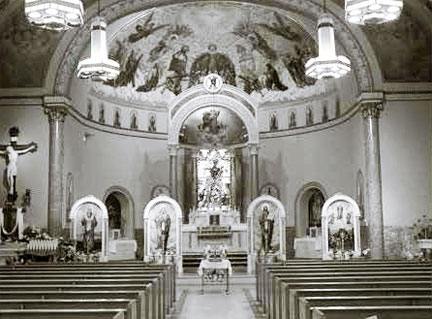 In 1996 the Holy See issued an Instruction directing the Eastern Catholic Churches that had adopted a series of devotions of the Latin Church, such as Stations of the Cross, Novenas, May Crowning and so forth, to discontinue these practices and instead implement devotions more authentic to Eastern Tradition. In 1999, Reverend Edward G. Cimbala, D. Min., a parish vocation, was assigned as pastor. His focus was to prepare the parish for the implementation of the Holy Father's directives. He immediately began a program of instruction to educate the faithful in their authentic Tradition and customs. Father Ed, as he was affectionately known, developed plans to install an Iconostasis to replace the one removed in the late 1950's. Free-standing frames were constructed and four of the original large Icons were removed from the walls and placed inside the frames to form a "type" of Iconostasis in preparation for the "real" one yet to come. In 1996 the Holy See issued an Instruction directing the Eastern Catholic Churches that had adopted a series of devotions of the Latin Church, such as Stations of the Cross, Novenas, May Crowning and so forth, to discontinue these practices and instead implement devotions more authentic to Eastern Tradition. In 1999, Reverend Edward G. Cimbala, D. Min., a parish vocation, was assigned as pastor. His focus was to prepare the parish for the implementation of the Holy Father's directives. He immediately began a program of instruction to educate the faithful in their authentic Tradition and customs. Father Ed, as he was affectionately known, developed plans to install an Iconostasis to replace the one removed in the late 1950's. Free-standing frames were constructed and four of the original large Icons were removed from the walls and placed inside the frames to form a "type" of Iconostasis in preparation for the "real" one yet to come.
In 2000 the school, which had been in continuous use since its construction in 1921, was closed due to insufficient enrollment and escalating costs. It was truly a sad rupture in an otherwise vibrant parish community. Later that same year, through the guidance of Father Ed, the vacant school building was leased to the City of Trenton for a period of five years.
On July 1, 2002, the Very Reverend Gregory J. Noga assumed the pastorate of Saint Mary's. After a few months Father Noga set about implementing the plans the parish council and finance committee had developed. Soon a ramp was constructed to facilitate entrance to the church and a lavatory was installed in the narthex capable of accommodating physically challenged individuals.
The year 2003 proved to be both challenging and difficult. A parish convocation was conducted to determine what plan of action might realistically be implemented. Should the parish relocate or remain in the city? If remaining in Trenton was the answer, then what repairs and renovations should take place? The parishioners also learned that the Chapel in Robbinsville would close and the property would be sold. Unfortunately, the property was too small for expansion and the parish could not afford to relocate and maintain two locations, nor was it reasonable to maintain two separate facilities when the church in Trenton was sufficiently large.
Also in 2003, a contractor was asked to evaluate the massive bell towers and provide a proposal for repairing the damage. Bishop Andrew Pataki, and Father Noga reviewed both this proposal and the engineering and architectural report prepared by A.J.S.A. architects, specialists in restoration and repair of old buildings, commissioned by Father Greg the previous year. Ultimately, the proposal of Francis Hutta Builders, Inc. was accepted. Thus began the three year project that involved not only the repair of the church's towers, but the replacement of the slate roof, flashing and rain gutters, repainting of the cupolas and gilding of the distinctive triple bar crosses that immediately identify the church's Eastern heritage.
Simultaneously, the firm of Marbleworks, Inc. was contracted to remove the pre-Vatican II Latin style altar, steps and baldachin that was part of the renovation during the 1950's. The uneven floor surrounding the altar was resurfaced and overlaid with perlato marble. In keeping with Eastern tradition, a five feet square Holy Table was installed. The terrazzo floors in the nave and vestibule were refinished and the pews were reset with greater depth between them. The new spacing facilitated ingress and egress thus enabling ease of quad-cane and walker use for the physically challenged. Lastly, a new Iconstasis and Icons were installed. Although these changes were completed by 2006, it was another two years before the church could be painted and the lighting refurbished.
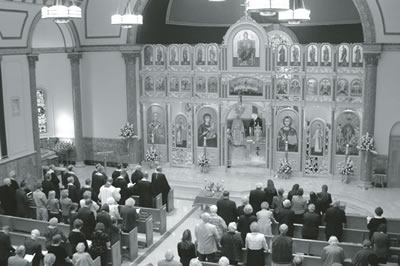 On October 26, 2008 the restored and newly renovated church was solemnly rededicated. The new Iconostasis was blessed and the Holy Table was consecrated by the hand of the Most Reverend William C. Skurla, D.D., Bishop of Passaic. Assisting the bishop at the Altar were: The Very Reverend Michael J. Mondik, Syncellus of New Jersey; the Very Reverend Gregory J. Noga, pastor and Protopresbyter of the Central New Jersey Protopresbyterate; the Reverend Monsignor Nicholas I. Puhak, former pastor; Reverend John J. Zeyack, parish vocation; Reverend Edward G. Cimbala, parish vocation and former pastor; Deacon Thomas L. Vanisko, parish deacon and Deacon Robert Berhens. Following the liturgical program the clergy and parish family enjoyed fellowship at the German American Society banquet facility in Yardville, NJ. On October 26, 2008 the restored and newly renovated church was solemnly rededicated. The new Iconostasis was blessed and the Holy Table was consecrated by the hand of the Most Reverend William C. Skurla, D.D., Bishop of Passaic. Assisting the bishop at the Altar were: The Very Reverend Michael J. Mondik, Syncellus of New Jersey; the Very Reverend Gregory J. Noga, pastor and Protopresbyter of the Central New Jersey Protopresbyterate; the Reverend Monsignor Nicholas I. Puhak, former pastor; Reverend John J. Zeyack, parish vocation; Reverend Edward G. Cimbala, parish vocation and former pastor; Deacon Thomas L. Vanisko, parish deacon and Deacon Robert Berhens. Following the liturgical program the clergy and parish family enjoyed fellowship at the German American Society banquet facility in Yardville, NJ.
A second church convocation is planned for the early part of 2009. Primary points of focus will be the formulation and articulation of parish goals concerning evangelization and education as well as the financial strategies to achieve them.
Throughout the one hundred and seventeen years since the beginning of this parish, the Byzantine Catholic community of the Trenton area has been blessed by dedicated pastors, loyal and generous parishioners, and leaders of parish organizations who have devoted countless hours to support our parish financially, spiritually, and socially. With God's blessings, this will continue.
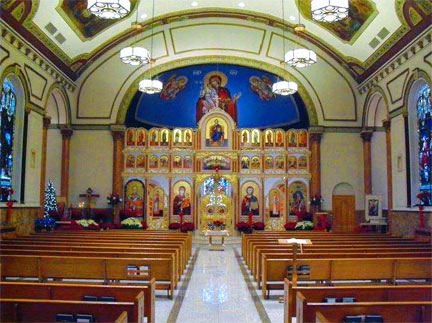 Assumption of the Virgin Mary Byzantine Catholic Church (Official Site) Assumption of the Virgin Mary Byzantine Catholic Church (Official Site)
Holy Spirit Byzantine Catholic Church
Mahwah, Bergen County, New Jersey
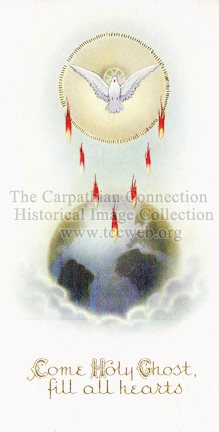 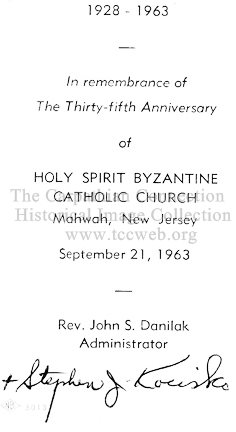
The back of the sign has a marker
In Loving Memory of Michael Patrick Feb. 4, 1917-Mar. 21, 1999

 
During the turn of the century, thousands of individuals came to America from the former Austro-Hungarian Empire. Many immigrants settled in Passaic, Garfield and Clifton, New Jersey. However, a number of immigrants moved farther north to Suffern and Tuxedo New York including Mahwah, New Jersey. In 1915 Greek Catholics had no church of their own in this area close to the New York State boarder. Some attended Immaculate Heart of Mary Polish Roman Catholic church in Mahwah and others attended Sacred Heart Roman Catholic Church in Suffern, New York. To worship in their ancestral faith on major holidays or for important services such as marriages and baptisms, they traveled by train to Saint Michael’s Greek Catholic church (later Cathedral) in Passaic, New Jersey. During these early days, Father Michael Jackovics of Saint Michael’s travelled to Mahwah and performed liturgical services on a limited basis.

The initial meeting to begin Holy Spirit Greek Catholic Church was held on September 12, 1925. These members sought guidance from their Bishop, Basil Takach. He instructed them to seek assistance from Father Michael Jackovics. The original trustees elected for the church were John Luckas and Michael Micik as President. John Sima was elected Treasurer and some at the meeting were John Lucas, Stefan Tymcyzyn, Michael Micik, Zachary Hruscik, Ignatius Petrick, Stefan Gazda, Daniel Tymoch Michael Belovics, Basil Melnik, Andrew Fedor, George Homa, Michael Yuhas, Anthony Karpovich and John Balog. By 1926, Greek Catholics were attending services in Suffern, New York. During 1926 Greek Catholics held services at a community hall and later at a private home. Holy Spirit Church was originally incorporated as “Holy Ghost Catholic Church of the United Greek Catholic Rite.” From its inception until the 1960’s Holy Spirit would have pastors and assistant pastors from Saint Michaels Greek Catholic Church in Passaic tend to their spiritual needs.
Cornerstone

After making firm plans and raising funds, on August 19, 1928 a contractor and architectural firm was retained to construct the church. At that time, the cost was approximately $14,000 (today the cost would be approximately $200,000.) The construction progressed quickly and by August 29, 1928 the cornerstone was in place and blessed by Father Michael Jackovics of Saint Michaels in Passaic and Father John Dorohovich. When the frame of the church was erected Father Jackovics and Father Dorohovich blessed the three bar cross that was installed on the main church tower. Later, Father Jackovics and Father Dorohovich came to bless two bells for the church which were named Nicholas and Michael. Finally to all the members great happiness, on January 23, 1929 the church was ready for worship. In 1929 Bishop Basil Takach along with numerous Greek Catholic priests dedicated Holy Spirit Greek Catholic church. While the church had taken a mortgage to finance construction, it is to the parishioners’ credit that within a few short years the entire mortgage was fully satisfied.
During the hard years of depression and war, Holy Spirit’s parishioners stayed close to their church and worked hard to meet all financial obligations. The parish grew and by 1953 it was time to celebrate the church Silver Anniversary. On November 7, 1953 Benediction of the Blessed Sacrament was held and after this a full banquet was enjoyed by those in attendance. Some of the dignities who took part in the ceremonies at this joyful event were Father Joseph Haluch, Pastor of Immaculate Heart of Mary Roman Catholic Church Mahwah, Father Sergius Bachkovsky, Pastor of Saint Mary’s Greek Catholic Church in New York City and the Mayor of Mahwah, Charles N. Feldman. Within a short time after this event the entire church was completed remolded. Most Reverend Bishop Nicholas T. Elko rededicated the church. A Pontifical Liturgy was held and a banquet followed. In 1963 the first resident pastor was installed at Holy Spirit, Father John S. Danilak. Later, Father John Drozda was assigned to Holy Spirit and served the parishioners faithfully for a number of years. As more people who were Byzantine Catholic moved to the suburbs another Eastern Rite Church, Saint Paul Ukrainian Catholic Church, was started in the Mahwah area (Ramsey) in 1967. Holy Spirit continued to expand and in 1969 a large parcel of land was purchased for a parish center. In 1970, Father Nicholas Alishofski was installed as pastor and he worked tirelessly on exterior renovations for the church. He also managed interior renovations which included beautiful crystal chandeliers. During Father Alishofski’s tenure plans were implemented for a beautiful Icon of Christ which was painted by Baransky Studios of Yonkers, New York. This icon still remains on the wall behind the main altar.
 Holy Spirit Byzantine Catholic church has remained an important house of worship to Byzantine Rite Catholics in the Mahwah area. The church has been blessed with two vocations, Father Joseph Homa and Sister Ambrosia (Homa), O.S.B.M. A number of priests who served Holy Spirit during its early years were: Father Michael Jackovics (1926-1928, 1938-1939), Father John Dorohovic (1928-1934), Father John Parasconta (1934-1938), Father Eugene Volkay (1940-1941), Father John Macko (1941-1944) and Father Roland Maruscak, O.F.M (1944-1949.) A very enjoyable function has been Holy Spirit’s annual church picnic. Held on the grounds of the church, this social event is an enjoyable time for parishioners and friends of the church. Another event the children of the parish look forward to is the annual Saint Nicholas celebration which is held in the hall of the church. The interior of Holy Spirit is very welcoming. The main altar is blue with a green stenciled boarder. On the left is an icon of the Virgin Mary and to the right is an icon of Christ the Teacher. To the far left is an icon of Saint Nicholas, Patron of the Byzantine Catholic Church and to the far right is an icon of the Decent of the Holy Spirit. Over the exterior entrance to the church is an icon of Christ which gracefully welcomes all those who enter for worship. For over 87 years, Holy Spirit Byzantine Catholic church has served the needs of Byzantine Catholics in this region of Northern New Jersey. The church confidentially looks to the future as a new generation of Byzantine Catholics will worship at Holy Spirit in the faith of their ancestors. Holy Spirit Byzantine Catholic church has remained an important house of worship to Byzantine Rite Catholics in the Mahwah area. The church has been blessed with two vocations, Father Joseph Homa and Sister Ambrosia (Homa), O.S.B.M. A number of priests who served Holy Spirit during its early years were: Father Michael Jackovics (1926-1928, 1938-1939), Father John Dorohovic (1928-1934), Father John Parasconta (1934-1938), Father Eugene Volkay (1940-1941), Father John Macko (1941-1944) and Father Roland Maruscak, O.F.M (1944-1949.) A very enjoyable function has been Holy Spirit’s annual church picnic. Held on the grounds of the church, this social event is an enjoyable time for parishioners and friends of the church. Another event the children of the parish look forward to is the annual Saint Nicholas celebration which is held in the hall of the church. The interior of Holy Spirit is very welcoming. The main altar is blue with a green stenciled boarder. On the left is an icon of the Virgin Mary and to the right is an icon of Christ the Teacher. To the far left is an icon of Saint Nicholas, Patron of the Byzantine Catholic Church and to the far right is an icon of the Decent of the Holy Spirit. Over the exterior entrance to the church is an icon of Christ which gracefully welcomes all those who enter for worship. For over 87 years, Holy Spirit Byzantine Catholic church has served the needs of Byzantine Catholics in this region of Northern New Jersey. The church confidentially looks to the future as a new generation of Byzantine Catholics will worship at Holy Spirit in the faith of their ancestors.
Saint George Byzantine Catholic Church
Newark, Essex County, New Jersey
By the year 1910 many Ruthenian, Galician and Hungarian immigrants of the Greek Catholic religion settled in Newark. Finding themselves in the need of a place to worship in their own faith, many turned to the spiritual leadership of Father Acacius Kaminsky. Father Acacius held their first Mass in a private dwelling on Lafayette Street. As their numbers expanded, they grew out of this space and the parishioners collected enough funds to purchase a larger structure on Bremen Street. Sadly, this location did not last as the building was lost in a terrible fire.
In October of 1919, twelve men of the parish met to discuss how they might form a new church. Nineteen families immediately stepped forward and pledged their determination to found a church. Since some of the men belonged to St. George’s lodge, they decided to dedicate the new church under the patronage of Saint George. Father Michael Andreykovich of Jersey City, New Jersey, heard of these efforts by the new congregation. He immediately offered his assistance and a charter was formulated. Within a few months a building on 28 Houston Street with two adjoining lots was purchased for $5,000. On the fifth Sunday of Lent, 1920 Father Andreykovich celebrated the first Mass in the new Saint George Greek Catholic Church. The Church was blessed on Memorial Day, 1920 by the Apostolic Administrator Monsignor Gabriel Martyak.
Some of the founders of St. George's were: George Varchola, John Gorey, John Hencoski, Jr., Andrew Masko, John Hencoski, Sr., Stefan Sedlar, Joseph Yurechko, Stefan Ridilla, Michael Vasilik, John Milko, Paul Gergel, Andrew Varcho, Michael Voynik and Andrew Smisko.
Original St. George's on Houston Street (Google Street View)
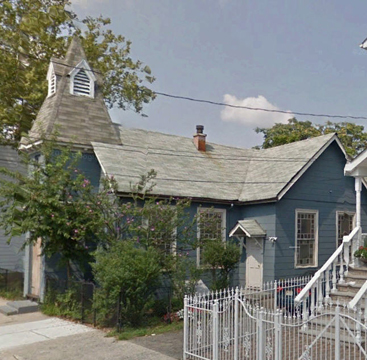 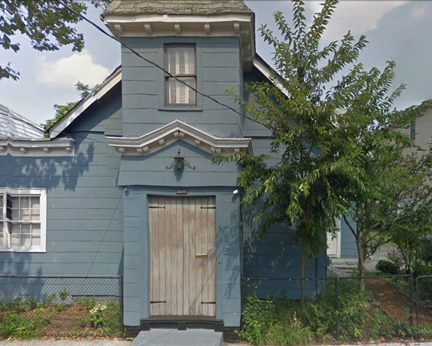
As the congregation grew, everyone realized they needed a larger church. In 1923 the congregation purchased a corner property on Lang and Warwick Streets for the sum of $4,600. In October 1928, Bishop Basil Takach assigned the first resident pastor, Father George Kandra. Plans for building the new church moved forward. Ground was broken on
July 11, 1952. Bishop Takach was present for the laying of the cornerstone on
November 15, 1932. By the spring of 1933 the exterior was completed and the
interior roughly furnished. However, further progress was halted as the parish ran out of funds. Nine years later, in 1941 with contributions from the faithful and a private loan secured furnishing of the church interior went forward. On Sunday, May 5, 1942 Saint George’s Greek Catholic Church was finally completed.
Present St. George's on Lang and Warwick Streets (Google Street View)
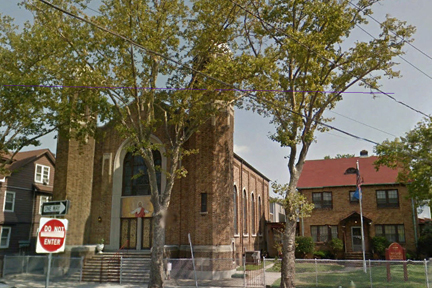
Father George Berzinec came to Newark in 1955. During his pastorate
the church was artistically decorated and the Crucifixion and Blessed Mother
Shrines were built on the corner across from the church. By 1965 when
Father Michael Dudick became the pastor, the church numbered 100 families.
During his pastorate the church interior was redecorated and remodeled.
In 1964 during the episcopacy of Bishop Stephen Kocisko, Father Dudick
honored by Pope Paul VI with the title of Monsignor. In 1968 Monsignor Michael Dudick was appointed by Pope Pau1 VI as the Second Bishop of the Eparchy of Passaic.
Shrines (Google Street View)
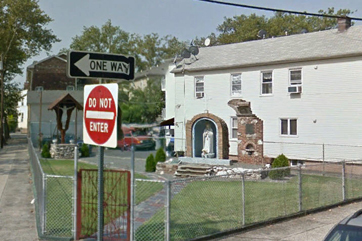
Monsignor Robert Moneta took charge at St. George’s Parish in September, 1968. In 1995 the parish celebrated its 75th Anniversary with a Pontifical Liturgy celebrated by Bishop Michael Dudick and a Testimonial Banquet was held in the parish hall. During September of 1998, Monsignor Robert Moneta marked his 50th Anniversary as pastor of Saint George’s Byzantine Catholic Church.
In July, 2015, Father Marcel Szabo, former pastor of Saint Michael’s Cathedral in Passaic was appointed as administrator of Saint Mary’s. The faithful, along with their new pastor, look forward to a prosperous future for their parish.
Anniversary Book Photo - 1971
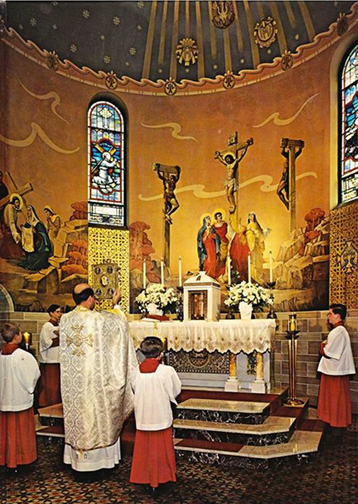
Saint John the Baptist Byzantine Catholic Church
Bayonne, Hudson County, New Jersey
Anniversary Book Photo
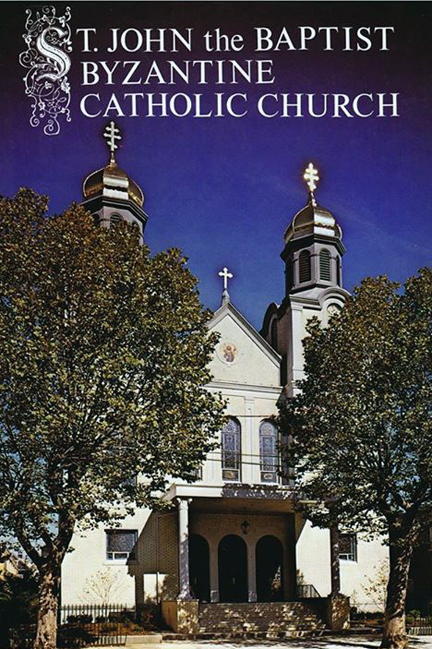
In 1897 a small group of Ruthenian and Lemko immigrants organized to establish a church to worship in their ancestral faith. The newly organized Greek Catholic congregation was dedicated to the patronage of Saint John the Baptist.
On August 22, 1897 the congregation had grown sufficiently to enable the purchase of land at 22nd Street and Avenue H. The cornerstone for the church was placed on December 4,1897 and the construction of this first Greek Catholic Church
in Bayonne was completed not long afterwards. Reverend Elias Goydich, who served the parish from 1902 to 1905,was the first regular resident pastor.
Tragedy struck the growing parish on January 19, 1904 when the church was completely destroyed by fire. The devoted parishioners lost no time in raising the necessary funds and in the following year, a new brick church was constructed. During the ensuing years, the parish had increased in such great numbers that the church building became inadequate.
Father Emil I. Burik was appointed pastor in 1919. He oversaw and completed negotiations for the present property. Dedication and blessing of the new church was held on Memorial Day in 1922.
St. John's Iconostasis, Then and Now (Only the upper portion of the original Iconostasis remains. Over time some of the original murals were replaced)
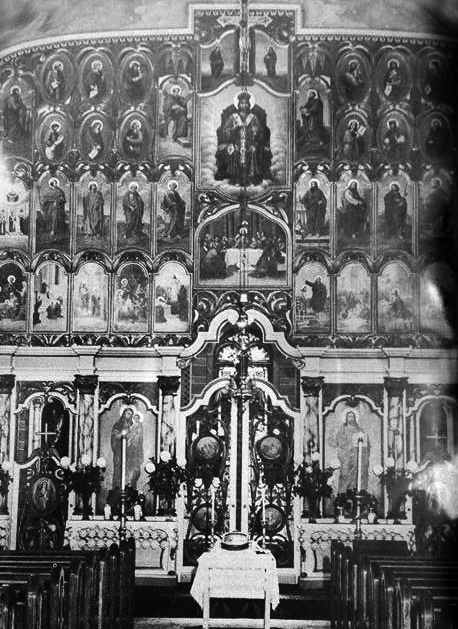 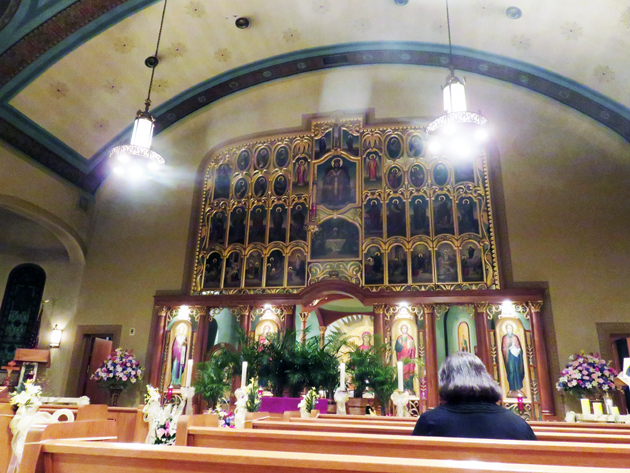
During the pastorate of Reverend George M. Kandra a parish center was built and dedicated on August 15, 1965. Reverend Alan J. Borsuk was sent to assist and to administer the parish as Father Kandra's health began to fail. Plans were being made to completely renovate the interior and exterior of the church. After Father Kandra's death on January 27, 1977, the renovations begun were completed by Reverend Robert J. Radvansky. The old rectory was demolished and groundbreaking for the new rectory took place on june 24, 1978.
Saint John's is the home parish of Blessed Sister Miriam Teresa Demjanovich. Blessed Sister Miriam was baptized at Saint John’s in 1901 by Father Theodore Stefan. She received her first Holy Communion at Saint John's and later, entered the Roman Catholic order of the Sisters of Charity convent. On October 4, 2014, she was beatified by Pope Francis and the Mass of Beatification was held at Sacred Heart Basilica in Newark, New Jersey. Blessed Sister Miriam Teresa Demjanovich was the first Greek Catholic of Ruthenian heritage to be beatified in the United States.
Shrine to Blessed Sister Miriam Teresa Demjanovich (Easter-2018)
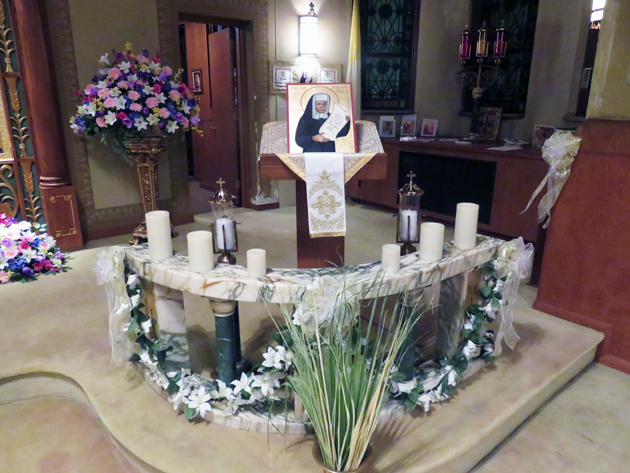
In July of 2015, Father Marcel Szabo, former pastor of Saint Michael’s Cathedral, Passaic, New Jersey was appointed to lead Saint John’s Byzantine Catholic Church. Saint John’s stands today as a tribute to the original devout parishioners who sacrificed to establish this parish over 100 years ago.
Rear of Church and Choir Loft (Easter-2018)
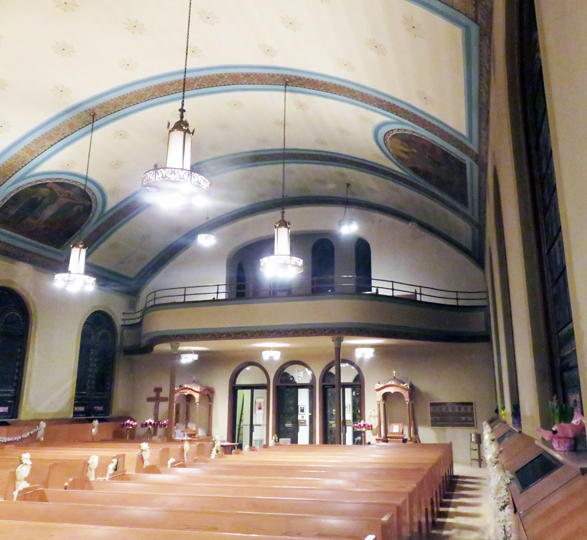
Saint Joseph Hungarian Byzantine Catholic Church
New Brunswick, Middlesex County, New Jersey
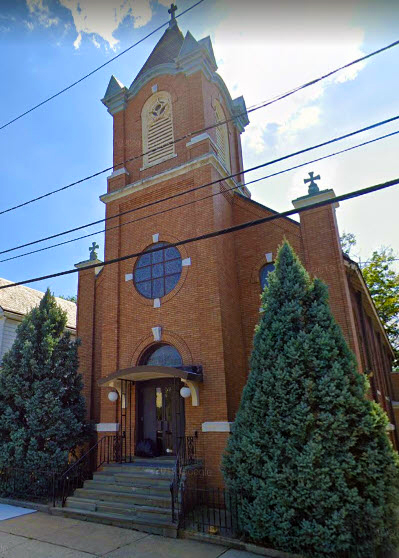
During the turn of the century numerous immigrants came to New Brunswick. This city has always been noted for its ethnic diversity. During the 1930’s census figures show one quarter of the population was Hungarian. Hungarian immigrants arrived in New Brunswick in 1888 and by 1915 made up 20% of the population. Many churches were begun to serve the spiritual needs of the Hungarian community. Some were the Magyar (Hungarian) Reformed Church, Ascension Lutheran Church, Saint Ladislaus Roman Catholic Church and Saint Joseph’s Hungarian Greek (Byzantine) Catholic Church. On April 9, 1914, Hungarians who were of the Greek Catholic faith and other ethnic backgrounds such as those from Transylvania began Saint Joseph’s. The immigrant community worked hard and in 1915, Saint Joseph’s was constructed on High Street. During the 1920’s the parish grew. Property was purchased outside of the city and is used to this day for various events including parish and Hungarian society picnics.
During the 1956 Hungarian Revolution against the communist regime, thousands of refugees came to the United States. Many arrived in Edison and those of the Greek Catholic faith joined Saint Joseph’s. The faithful of the church are dedicated and numerous improvements have been made throughout the years. The exterior of the church was constructed of red brick with one steeple. A three floor rectory made of the same brick is located next to the church. The interior of the church has retained a good deal of its original ornamentation. On the middle ceiling are beautiful murals of Jesus Christ risen from the dead and the Nativity. A lovely chandelier hangs down from the ceiling murals. Stations of the Cross adorn each side of the church. The colors of the church are red and gold. A partially open altar has a mural on the back wall of the Virgin Mary and child Jesus. Two original murals, that of Jesus Christ praying in the garden and Abraham going to sacrifice his son, grace the tables of preparation. Four stunning stained glass windows are on each side of the church. Two side altars are on the left and right of the main altar. The left is of the Virgin Mary and the right is of Jesus Christ. The American Flag is on the left of the altar area with the Papal and Hungarian Flag to the right. In-between the church and rectory is a statue of Our Lady of Fatima with the three children who saw her in 1917.
The Hungarian presence in New Brunswick is everywhere to be seen. The City hosts a Hungarian Festival yearly in June and there are many Hungarian groups and organizations still in existence. The first statue of Cardinal Jozsef Mindszenty was placed on Somerset and Plum Streets. There is also a street and park name for Lajos Kossuth, one of the leaders of the Hungarian Revolution (1848) against Austro-Hungarian Empire rule. While the numbers of parishioners have decreased in recent years, Saint Joseph’s still continues to thrive. They hold one Mass each Sunday at 10 am and other events throughout the year. They also have been live-streaming services for shut-ins and those who cannot attend church since December of 2019. The current Pastor of Saint Joseph’s is Father Mykhaylo Kravchuk. Saint Joseph’s Hungarian Byzantine Catholic Church has come far in their 106 year history. The parishioners look to the future with enthusiasm for the next 100 years.
Saint Mary’s Byzantine Catholic Church
Hillsborough, Somerset County, New Jersey
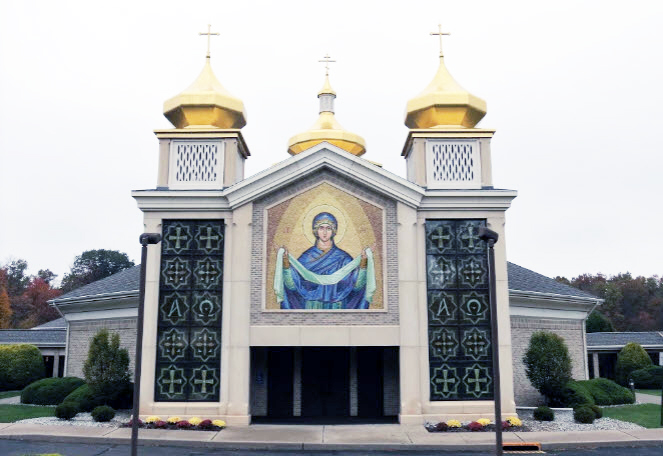
During the turn of the century, numerous immigrants came to the United States seeking employment. Many came to the area that was a portion of Hillsborough Township which had been founded in 1771. The township of Manville would not be incorporated until 1929 and it would become an extension of Hillsborough. Prior to 1929, the Johns-Manville Products Corporation constructed their factory. They were the largest producer of asbestos in the world and the need for employees expanded. It was during this period many came from the former Austro-Hungarian Empire regions. Ruthenians, Slovaks, Polish, Ukrainians, Hungarians and other ethnic backgrounds made up the rising population. As there was no Greek Catholic church, on July 22, 1917 a meeting was held to begin one. Father Alexis Medvecky of Saint Elias Greek Catholic Church represented Father Gabriel Martyak who was Administrator of the Greek Catholic Church in America. Some of the faithful in attendance were John Volosin, Mike Hritz, Nicholas Kepenach, John Pavol, Andrew Petrilyak, John Siddur, Nicholas Visnik and Joseph Kupcha.
After discussing all options, a plan was finalized to build a church. Andrew Petrilyak, John Risko and Nicholas Kepenach were nominated to find land for this purpose. Parishioners were assessed $30 per family and $15 for a single person to support the building fund. It should be recognized that these sums were not small for 1917. $30 today would be approximately $665 dollars and $15 would be $332 dollars. These amounts were high considering the majority of parishioners worked as laborers in a factory setting. However, wishing to have their own Greek Catholic Church, they knew they had to pay these costs. The church name was decided as the Greek Catholic Church of the Assumption (Dormition) of the Mother of God. As these plans were made a month prior to August 15th (which is the feast day of the Assumption of the Virgin Mary) the members named their church after her holy day. Parishioners came from various areas around Manville such as Raritan, Bound Brook, Somerville, Dunellen and Flemington. Finally, on July 28, 1917, the church was incorporated according to state and church law. The original charter for the church was signed by Father Gabriel Martyak, Father Alexis Medvecky and three trustees were installed, Andrew Petrilyak, Nicholas Kepenach and John Haydra.
Four lots of land were secured and the purchase price was $775. On September 15, 1917, construction began on Main Street with the Krug Construction Company for a total of $5,806. As the contractor built the church, services were held in the basement of John Risko’s home. Later, services were offered at Tony Majka’s Hall on Camplain and South 7th Avenue. Christmas and Easter were celebrated in Firehouse No. 1 by Father Victor Kavalitsky of Saint Michael’s Hungarian Church in Perth Amboy, New Jersey. The church also received assistance from the priests at Saint Joseph’s Hungarian Greek Catholic Church in New Brunswick, New Jersey and Saints Peter and Paul Greek Catholic Church in Phillipsburg, New Jersey. To pay the contractor, a mortgage was obtained for the property in the amount of $5,000. Things did not go smoothly with construction and the original contractor could not complete his work. Another contractor had to be retained to finish the project. Parishioners who had various skills gave of their time and talents and performed carpentry work at no cost. The church had an original iconostasis constructed by these men that sadly, was removed during a renovation many years later. Saint Mary’s was served by a number of clergy, some being Father Alexis Medvecky, Father John Yanitsky, Father Peter Kustan and Father Anthony Kubek. Father Emil Semetkovsky was assigned as a permanent priest at Saint Marys. Since the church did not have a rectory, a room was rented for him on South Main Street. During 1925, Father Methodius Goydish was installed as pastor. He resided at the Johns-Manville Asbestos Hotel which later was the headquarters for the corporation. After Father Methodius, a number of priests came and went as pastor.
Father Daniel Medvecky was assigned to Saint Mary’s and during his tenure the mortgage for the church was satisfied. Father Daniel died in 1952 and Father Julius Marina was assigned to Saint Mary’s on November 23, 1952. During his tenure, many structural improvements were made to the church, a new roof was installed and the belfry was reinforced. The church was rededicated by Bishop Daniel Ivancho, Apostolic Exarch of Pittsburgh. Father Julius also saw to the spiritual needs of the faithful. He began a Sodality of the Virgin Mary Society on April 22, 1953 and a Rosary Society on October 1, 1954. An outdoor shrine dedicated to the Virgin Mary was donated by the Altar Society in remembrance of Father Daniel Medvecky in 1954. On August 8, 1957, Father John Gaspar was installed as pastor of Saint Mary’s. He had central air conditioning placed into the church and began holding services fully in English. On October 1, 1967 Saint Mary’s celebrated their Golden Jubilee. Bishop Kocisko was the main celebrant for the Jubilee Mass and a banquet with over 900 faithful was held afterwards. Saint Marys has continued to grow throughout the years. The church offers an extensive ECF program for young people. The church choir is full with one Cantor and two assistant Cantors which is almost non-existent in churches today. Raising funds for the church and societies see various events such as an annual tricky tray, monthly Slavic dinners, Bingo, Saint Nicholas Day dinner and an annual church picnic.
In 2002, Father Edward Cimbala was installed as Pastor of Saint Mary’s. He would remain for 14 years and during his tenure the church completely dissolved a one million dollar mortgage along with parishioners paying for a $200,000 icon project. He went on to promote numerous educational, cultural and community programs within the parish. In 2017 the church held their 100th anniversary. As a souvenir of this milestone, a round gold ornament with a relief of the church in the middle and the name of the church surrounding it was offered. The church holds numerous services and has a Saturday night Mass at 4 pm and Sundays at 8 am and 10:30 am. The church has expanded during its 103 year history, first with the old church on Main Street in Manville and then the new church on Brooks Boulevard in Hillsborough proper. The current Pastor is Father Rev. James Badeaux and Saint Mary’s looks to the future while remembering those in the past who made this all possible.
Saint Mary's Byzantine Catholic Church
Jersey City, Hudson County, New Jersey
Google Street View
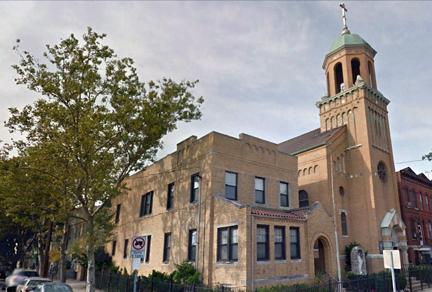
Immigration to Jersey City, New Jersey from the former Austro-Hungarian Empire began in the later 1870’s. During 1887, Ukrainian and Ruthenian Greek Catholics began Saints Peter and Paul Greek Catholic Church. One of the founders of this church was a Lemko, Pavlo Filak, from Luhy, Gorlice District, present day Poland. By early 1915, language dialect and cultural differences led 24 Ruthenian families in the Lafayette section of Jersey City to form their own church. By the end of that year their number had grown to 65 families. They held Sunday and holy day services in an old rented school house served by visiting clergy. In May1916 Father Paul Staurovsky was appointed as resident pastor. During that year property on the corner of Pacific and Bramhall Avenue, which included a brick house and two empty lots, was purchased for $9,600. This now served as their temporary place of worship.
The parish was originally known as St. John the Baptist Greek Catholic Church. On March 7, 1917 the parish was formerly incorporated and the name changed to St. Mary’s Greek Catholic Church. At this time, Fr. Staurovsky was appointed to St. ]ohn’s Greek Catholic Church in Bayonne, New Jersey and St. Mary’s became a mission parish served by Fr. Staurovsky and other priests. In June 1919 Father Emil Burik was appointed as pastor of the Bayonne parish and administrator of St. Mary’s. He began the excavation for the church hall.
In the fall of 1920 Fr. Michael Andreykovich was appointed resident pastor of St. Mary’s, an assignment he held for nineteen years. On Labor Day 1920 the cornerstone for the basement was blessed and the first Christmas Mass was held in the church hall. By 1928 the influx of Eastern Europeans into the Jersey City area increased to 120 families.The faithful made generous contributions and along with loans, the upper church was built in 1929. By 1954 Fr. Andreykovich, an accomplished musician, organized St.Mary’s Choir appointing Steve Gerzanich as director. The choir had many distinguished directors including Professor John Kahanick, Michael Artim, and George Kmeck. Under Mr. Kmeck’s guidance the choir recorded records, tapes and CDs of liturgical music.
By 1959 with St. Marys roster of 150 families, Fr. Nicholas Stulakovich was appointed pastor. He improved the parish property by erecting the present rectory, which was blessed and dedicated on May 30, 1941.
In May 1966 Fr. Alan Borsuk was appointed pastor. He began extensive renovations such as repainting, carpeting, lighting, electrified church bells, air Conditioning, a new garage, a new marble altar and new icons. It was also during this period that the church hall was completely renovated.
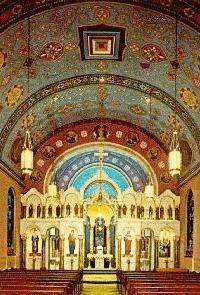
In February 1977 Father Edward Semko was appointed pastor. His adult enrichment classes were excellent and very well received during his ten years at St. Mary’s. He served as celebrant and narrator in three of the church's choir recordings.
In July 1987 Father Robert Skurla was assigned to St. Mary’s. He had the church and rectory repainted, the parking lot repaved, installed needed new entrance doors and replaced the tri-bar cross on the steeple as the original one was destroyed by hurricane winds.
In July, 2015, Father Marcel Szabo, former pastor of Saint Michael’s Cathedral in Passaic was appointed as administrator of Saint Mary’s. The faithful, along with their new pastor, look forward to a prosperous future for their parish.
Saint Michael’s Hungarian Byzantine Catholic Church
Perth Amboy, Middlesex County, New Jersey
Photo - St. Michael's Facebook Page
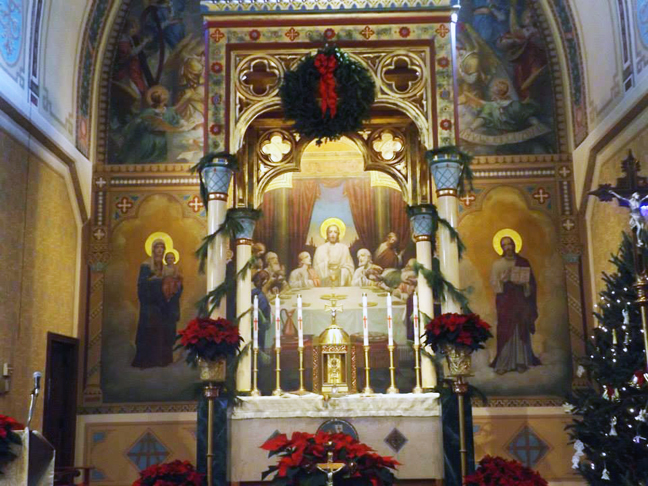
During the late 19th century numerous immigrants arrived in Perth Amboy, New Jersey. Many of these immigrants were Hungarian Greek Catholics. At first, they attended Saint John’s Greek Catholic Church in Perth Amboy. Wanting a church of their own, on October 27, 1912 a building fund was established for a future church. Father Victor Kovaliczky celebrated the first Greek Catholic Mass in Hungarian on December 19, 1915. Our Lady of Hungary Roman Catholic Church in Perth Amboy welcomed the Greek Catholics and gave them use of their church. At the end of December, a hall was purchased and Father Kovaliczky was installed as the first pastor. The parishioners worked to remodel the hall for services and on the Third Sunday of Lent, 1914, renovations were completed. On May 12, 1914 the church was approved for worship by Bishop Soter Ortinsky and the paperwork formally incorporated by the State of New Jersey on May 28, 1914.
During these years, immigration continued and more Hungarian Greek Catholics arrived in the Perth Amboy area. A large house was purchased in 1916 and converted into a rectory. Later five acres of land were acquired and set aside for use as the parish cemetery. Saint Michael’s membership swelled during these years and it finally became necessary to construct a new church. While this was developing, the church purchased another home in 1942 for a convent. The sisters that would be assigned to this convent took up teaching and religious instruction of the parish youth. Finally, due to increased membership, Bishop Basil Takach granted Saint Michael’s permission to build a new church. On May 30, 1957 he blessed and dedicated the newly constructed Saint Michael’s parish. On July 4, 1954 a new auditorium and parochial school were built. Bishop Nicholas Elko blessed the new buildings on July 3, 1955. The first kindergarten graduation of Saint Michael’s Hungarian Greek Catholic Parochial school took place on June 8, 1958.
Father Basil Rakaczky, OSBM was appointed pastor and he undertook a very extensive maintenance and upgrade project for the church and associated buildings. Father Basil was instrumental in establishing many spiritual retreats at his church and organizing pilgrimages for the faithful. During October of 1976, Saint Michaels was honored with a visit to their parish by the Auxiliary Bishop of the Greek Catholic Diocese of Hajdudorog, Hungary, Bishop Szilard Keresztes. In 1978, Saint Michaels was once again honored with a visit by Father Imre Timko, Ordinary (and later to become bishop) of the Greek Catholic Diocese of Hajduorog, Hungary. Sadly, as was the case with numerous Byzantine Catholic Churches in America, Saint Michael’s parochial school was closed in 1985. In that same year a “Catechist Association” was begun for the spiritual education of youth at Saint Michaels. The church celebrated their diamond jubilee in 1989 and the renovated church was rededicated by Bishop of the Byzantine Catholic Eparchy of Passaic Michael Dudick.
A heritage room was also constructed to preserve the history and culture of the church. Bishop Dudick also blessed the room during the rededication. Saint Michael’s Hungarian Byzantine Catholic Church, as of September 2017, has retained many traditional Greek Catholic elements. Their interior church as of that date had no iconostasis but instead a wood and medal altar railing. The church decorations included Stations of the Cross along each side of the church and magnificent murals. Behind the unique baldachino was a mural of the last supper. On the left back wall was a mural of the Virgin Mary with Child Jesus and to the right was Jesus Christ the Teacher. The entire focus is the altar which, is a work of art can be viewed without obstruction. Square in design, it is multi-colored and compliments the mural of the last supper behind it perfectly. The exterior of the church is made of brick and has a two bar cross on its steeple. To the left of the exterior church is a shrine area with a statue of Our Lady of Grace. At the time of this article, the pastor of Saint Michael’s Hungarian Byzantine Catholic Church is Father Marek Vavrak from Kosice, Slovakia. He studied at the Roman Catholic University in Ruzomberok, Slovakia and the Saint John Paul II Roman Catholic University in Lublin, Poland.
Saint Nicholas Byzantine Catholic Church
Perth Amboy, Middlesex County, New Jersey
.jpg) .jpg)
Saint Nicholas Greek Catholic Church began in the auditorium of Holy Trinity Roman Catholic Church in Perth Amboy, New Jersey. Father Michael Lukacs served the spiritual needs of the membership which moved to this building on October 13, 1935. Father Julius J. Grigassy was assigned as pastor and began construction of a new church and rectory on property that was purchased in 1940. During 1943, property was again purchased to be utilized as a cemetery as a final resting place of the parishioners. However, this was not the actual beginning of Saint Nicholas. Greek Catholic immigrants had come to Perth Amboy seeking employment and a new life in America. They banded together and began Saint John’s Greek Catholic church in 1897. The first pastor was Father Alex Kaminsky and the parish numbers multiplied until it was imperative to build a new church. These devout Greek Catholics donated generously and raised a remarkable $22,000.00 for construction costs.
The church was constructed at the corner of Broad and Division Streets. Father Alexis Novak served as pastor and the beautiful iconostasis was a replica of the one which today is located in Holy Cross Greek Catholic Church in Uzhorod, Ukraine. In 1913, twin towers were constructed and the church was very similar in architecture to Holy Cross in Ukraine. Saint John’s Greek Catholic Church was counted as being the largest Greek Catholic Church within the United States during this period. A parochial school was also built to accommodate the many children of parishioners. This Greek Catholic church continued to grow in numbers and financial security. Unfortunately, some members of the congregation began disruptions which would tear the church apart. This sad development forced those to leave who wanted to remain with their ancestral Greek Catholic faith. These members, who had given their devotion and finances to support Saint John’s were heartbroken, but, not defeated. They went on and began a new church, Saint Nicholas on Washington Street.
.jpg)
On Easter Sunday, April 17, 1949, services were held at the property that would become Saint Nicholas Byzantine Catholic Church. Bishop Daniel Ivancho blessed the cornerstone on September 11, 1949 and on April 2, 1950 (Palm Sunday) the first Mass was held. The church was officially dedicated on June 18, 1950. Some of the priests who have served Saint Nicholas throughout the years are Father Louis Sismis, Father Augustine Medvigy, Father Paul Barnyock and Father Robert Radvansky. The current pastor of the church is Father Martin Vavrak. The church exterior construction is very inviting with two small towers topped by sloping gold caps. The roof itself has multi-colored tiles that can be seen for quite a distance and are appealing visually. A wooden red and gold “Saint Nicholas Byzantine Catholic Church” sign is located to the left of the main entrance to the church. Also, set back to the left of the church is the rectory. A lovely statue of the Virgin Mary praying graces the center of the rectory front lawn.
The following description denotes how the church interior appeared prior to April of 2009. Prior to this time this Byzantine Catholic Church did not have an iconostasis. The altar was made of marble and had an inset last supper in various colors. There were two side altars, on the left was a mural of Our Lady of the Rosary and on the right there was a mural of the Sacred Heart of Jesus. At the entrance there was a serene statue of Our Lady of Grace. In the rear of the church there was an area for candles and a two bar crucifix and another statue of Our Lady of Grace.
On April 28, 2009 a new iconstasis and two side altars were blessed and re-dedicated by Bishop William Skurla, Bishop of The Byzantine Eparchy of Passaic, Most Reverend Bishop Andrew Pataki, Bishop Emitrius.
The faithful of Saint Nicholas have seen many trials during their history. However, they remained within their ancestral faith, built a new church and look forward to worshiping in their beloved Saint Nicholas for many years to come.
If you can identify anyone in this photo please contact us at editors@tccweb.org
Center is Father Julius Grigassy
Anna Ksenic Bandola, the third from the right in the second row and her husband Joseph Bandola, he is the third from the right in the top row.
Anna Ksenic Bandola 28 Oct 1919 - 17 Jan 2015
Joseph Bandola 25 Jan 1916 - 12 May 2007
The following identified by Marisa Lebeda Szamreta -
Sitting to the right of Father Grigassy, Cantor John Petach and to the very right of the bottom row is Joan Botis Kocun.
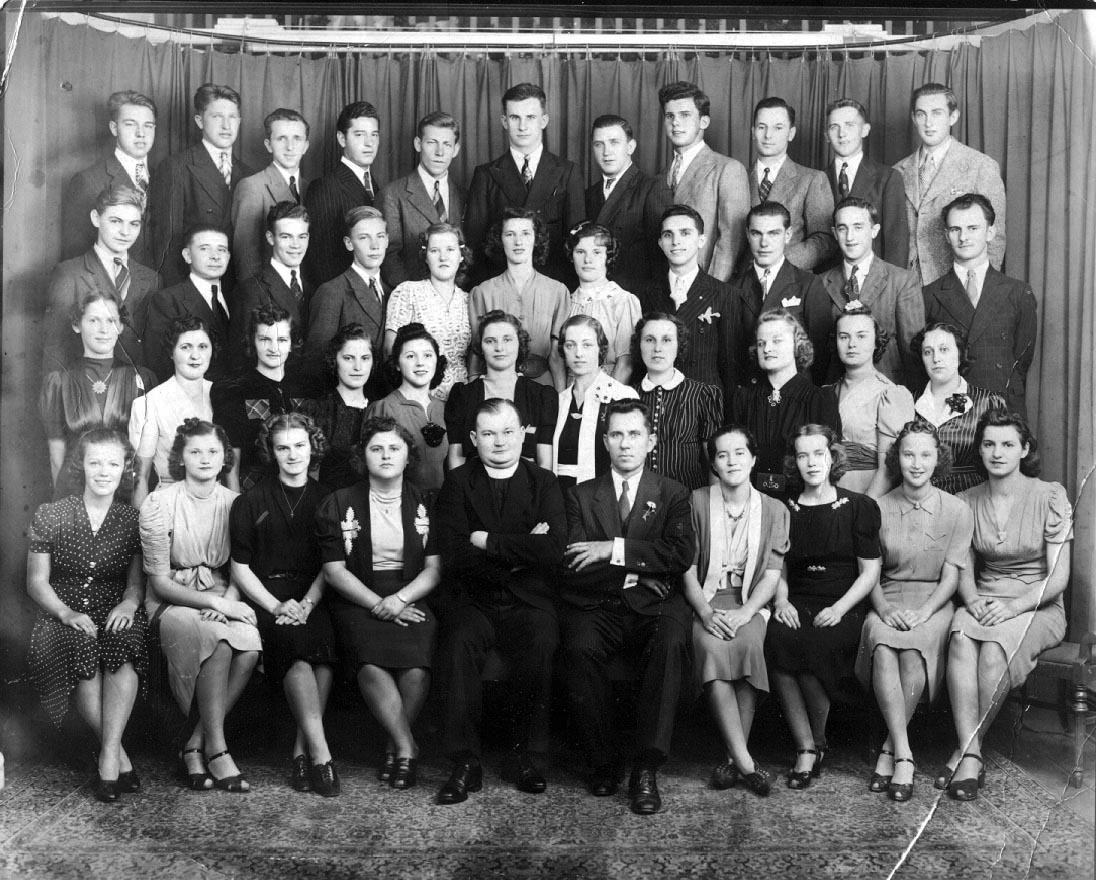
SS Peter & Paul Byzantine Catholic Church
Phillipsburg, Warren County, New Jersey
History
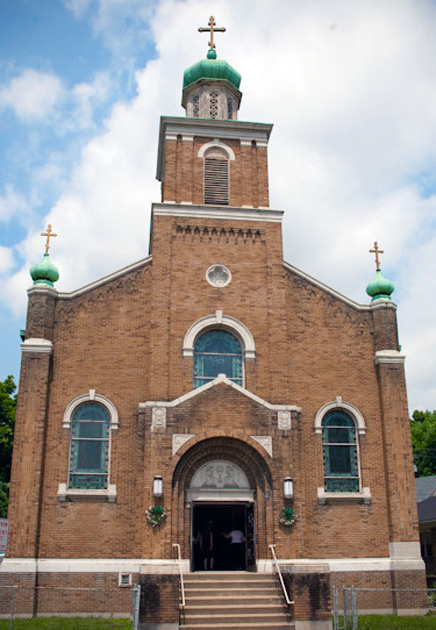 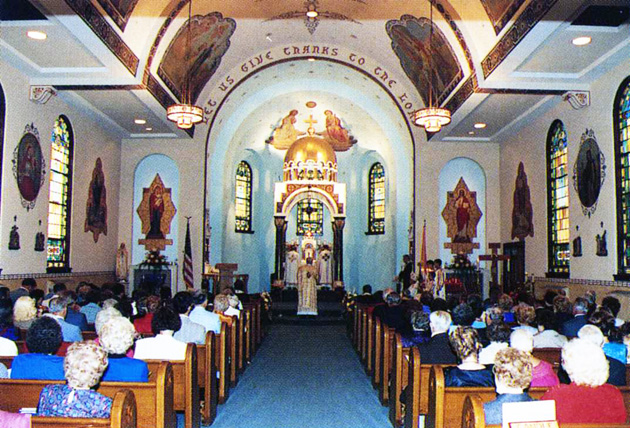
Saints Peter and Paul Greek Catholic Church was officially founded on March 5, 1916. Prior to this, Father Michael Mitro of Saint Michael’s Greek Catholic church in Allentown, Pennsylvania held services once a month in Saints Philip and James Church hall. The original founders of the church were Stephen Kravecz, Andrew Matviak, Joseph Chando, Joseph Sestak, Joseph Youpa, Stephen Boreczky, John Butchko, Jr., Michael Wilchak, Joseph Hnath, Michael Tkach, Nicholas Svachak, J. Jurachovski, H. Kyz, Peter Ridos, Nicholas Youpa, Andrew Lukachek, John Maczko, Sr., Mike Stangel and S. Regrut. Saints Peter and Paul had a close relationship with the oldest lodge of the Greek Catholic Union fraternal society. The Phillipsburg, New Jersey G.C.U. Lodge #186, was organized in 1899 and a Women’s Lodge #631 was organized in 1911. On January 10, 1916 members voted to purchase land for a future church building. The Lodge authorized a loan of $500.00 to complete the transaction.
After the construction period and when the church building was completed, Father Michael Andrejkovich blessed and dedicated the first church on Center Street. The cornerstone of Saints Peter and Paul was put into place on August 19, 1917 and a solemn dedication service was held on Memorial Day, May 30, 1918. After this, the church next proceeded to obtain land for a cemetery which was located in Alpha, New Jersey. The land purchased for the cemetery was sold to Saints Peter and Paul by a devoted member, Nicholas Youpa.
The cemetery was opened and dedicated on May 30, 1921. During these years, numerous Greek Catholic priests ministered to the spiritual needs of the growing parish. The need for a resident priest was necessary due to the expansion of the parish and in January 1921, a resident pastor, Father Emil Semetkovsky, was appointed for Saints Peter and Paul. The members of the church immediately set out to purchase a house on South Main Street and after remodeling and furnishing, the new rectory was complete. Saints Peter and Paul now had a resident full time priest to serve their spiritual needs.
During this period the church continued to expand. Members worked diligently to keep the interior and exterior of the church beautiful and many gave of their time and talents working for the church in various ways. The faithful of the Phillipsburg area were overjoyed at having their own parish as without it they had to travel long distances to other towns for services. However, on December 19, 1922 tragedy struck when the church burned to the ground. The members immediately began to organize and work to construct a new church. During this time members attended Saints Peter and Paul Slovak Roman Catholic Church who offered their church so Greek Catholic services could he held. The members decided not to renew the church at the burned property but to sell it, obtain the purchase price and build a new church on South Main Street. The cost of the property was $3,500 and the cost to build a new church was $7,355.00. On June 4, 1923 the new church was blessed and opened for worship by resident pastor Father John Krusko. In June, 1924, Father Krusko was reassigned and the church was placed under the administration of the priests at Saints Peter and Paul Greek Catholic Church, Bethlehem, Pennsylvania.
First Communicants in front of the second church, 1927
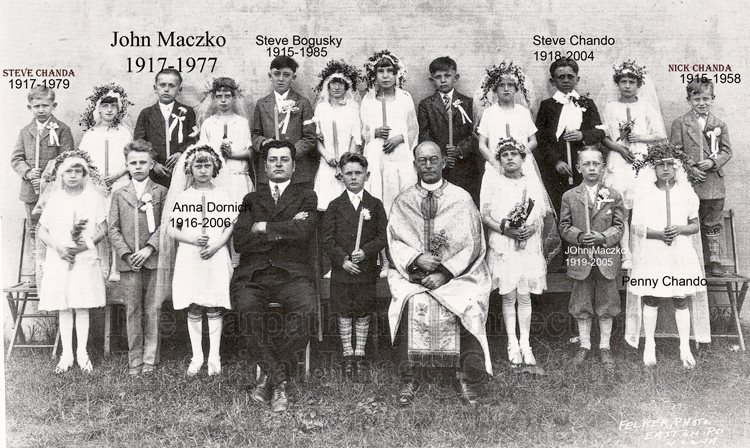
Saints Peter and Paul in Phillipsburg experienced phenomenal growth in these years. In 1929 the members decided to build a larger church to meet their membership requirements. Plans were made and along with a church, a full basement and hall area were added. The cornerstone was added and lists “St. Peter and St. Paul Greek Catholic Church 1930. Under the English title it is again written in Cyrillic lettering. The new church was fully completed in July, 1931 with loans totaling $36,000.00. During the great depression, the members and the parish were strained extensively. With a new church and outstanding debt, the members worked hard to satisfy the church financial obligations. It is a credit to all the devoted members of Saints Peter and Paul in Phillipsburg the church continued to grow and meet their bills when so many other churches closed. As the economy improved, plans were made to decorate and furnish the interior of the church. Father Email Nevitsky was an architect and he designed the new altar. The church interior was decorated in 1943 by Walter Boetcher with murals that were painted by Father Anthony Kubek. New side altars and pews were also installed at this time. Through all this, in the early months of 1947, the mortgage on the church was finally satisfied.
During the period of 1956 to 1980 many accomplishments were achieved. The Holy Name society was organized and the Sodality reorganized. The old boiler room was remodeled into a kitchen, a gas heating system was installed, a new oak floor constructed, repairs of the stained glass windows were undertaken and new sidewalks built. Also, wanting to help their church in all these endeavors, the devout ladies of the parish offered funds from their “pirohi” projects for the purchase a new parking lot. It was also at this time period the murals painted by Father Anthony Kubek were restored to their original beauty and new lighting fixtures were placed inside the church.
A listing of clergy who served from inception to the present at Saints Peter and Paul in Phillipsburg are: Father Michael Andrejkovich, Father Michael Mitro, Father Michael Andrejkovich, Father Stephen Gulyasy and Rev. John Krusko. Father Emil Semetkovsky, Father. Ireneus Janitzky and Father. Emil Nevitsky. Father John Krusko, Father Basil Lipeczky, Father Alexis Bakajsa, Father Emil Moskva, Father Nicholas Bonetsky, Father Joseph Milly, Father Basil Stankaninecz and Father Michael Chubirko, and Father Stephen Safko. At the present time the church is without a resident priest.
During its long and sterling history, five cantors served Saints Peter and Paul from 1917 to 1928. In 1928 George Mitroka served as cantor of the parish until his retirement in 1972. During his forty five years of service, he was also a cantor in the Bethlehem church. Michael Pataki and Edward Chando also served as cantors upon Mr. Mitroka’s retirement. After Michael Pataki was ordained as a permanent Deacon, Edward Chando continued to serve faithfully as cantor at all liturgies and services until 1981. After 1981, the church religious education program became active in the annual May Crowning and Christmas pageants. They also instituted a food collection program for the needy of the parish during the Thanksgiving holidays. A Fun and Travel Club was also organized which offered numerous social activities for seniors and friends of the church. The Holy Name Society has sponsored Lenten fish dinners and other activities such as spaghetti dinners and the fall Halupki sale are enjoyed by members and those from the surrounding community.
During its 95 year history Saints Peter and Paul Greek Catholic church has devoutly maintained their faith and heritage. This church has experienced positive growth and transition. It is a testament to every member who sacrificed so future generations may also continue to worship within the traditions of their Greek Catholic faith.
May Crowning 1963
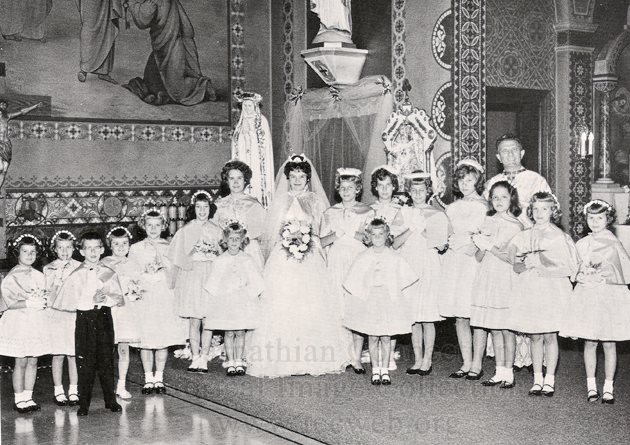
Oldest Living Married Parishioners in 1991
Vechnaya Pamyat - Eternal Memory
In 1991 Michael Osifchin Age 89 and wife, Anna Osifchin nee Sokol Age 86 were the Oldest Living Married Parishioners at Sts. Peter & Paul. They were wed on the 4th of November 1924 at St. Demetri's Greek Catholic Church in Ujak, Slovakia by Father Teodor Kello. Witnesses to their marriage were Nicholas Petrisin and Michael Hrina. In 1994 they celebrated their 70th Anniversary. They were parishioners of Sts. Peter & Paul for over 65 years.
Mr. Osifchin was born in Mildred, Pennsylvania, returned to his father's village of Ujak, Slovakia in 1911 and came back to the U.S. in 1925. His wife Anna was born in Ujak and joined her husband along with their son Michael, Jr. in 1927.
Michael Osifchin 1902-1994 / Anna Osifchin Nee Sokol 1905-1996
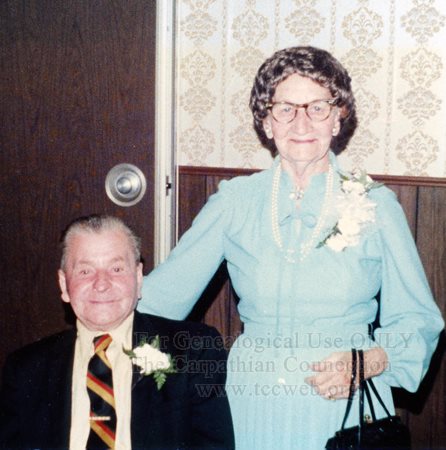
Oldest Living Married Parishioners in 1991
Bertha Choma nee Bulina age 99
Mrs. Choma was born in "Linci" in the former Czechoslovakia. She was the wife of John Choma.
Bertha Choma nee Bulina 1892-1994
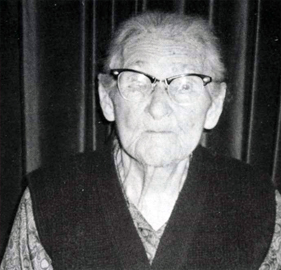
Julia Kravchak nee Fechisin Age 88
Mrs. Kravchak was a native of Ujak, Slovakia. She wed her husband John Kravchak in 1920 at St. Demetri's Greek Catholic Church in Ujak. She immigrated to the U.S. in 1923 and was a parishioner of Sts. Peter & Paul for over 65 years.
Julia Kravchak nee Fechisin 1903-1992
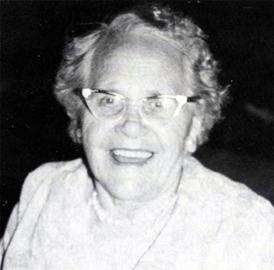
Kathyrn Lesko nee Ribovich Age 93
Mrs. Lesko was a native of Jakubany, Slovakia. She wed her husband Joseph Lesko a native of Maly Lipnik, Slovakia in 1917. She was a parishioner of Sts. Peter & Paul for over 70 years.
Kathryn Lesko nee Ribovich 1897-1994
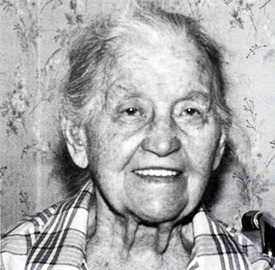
Anna Reyda nee Minchak Age 88
Mrs. Reyda was a native of Inovec, Slovakia and the wife of John Reyda.
Anna Reyda nee Minchak 1903-2000
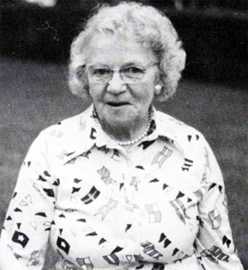
Mary Sestak nee Svachak Age 89
Mrs. Sestak was a native of Maly Lipnik, Slovakia. She wed Joseph Sestak a fellow villager in 1919 at Sts. Peter and Paul Greek Catholic Church.
Mary Sestak nee Svachak 1902-1996
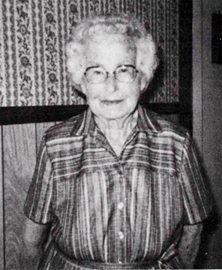
The following three religious prints were from the original Saints Peter and Paul Greek Catholic Church that burned down in 1922.
Mrs. Maria Chanda acquired the prints from the parish priest.
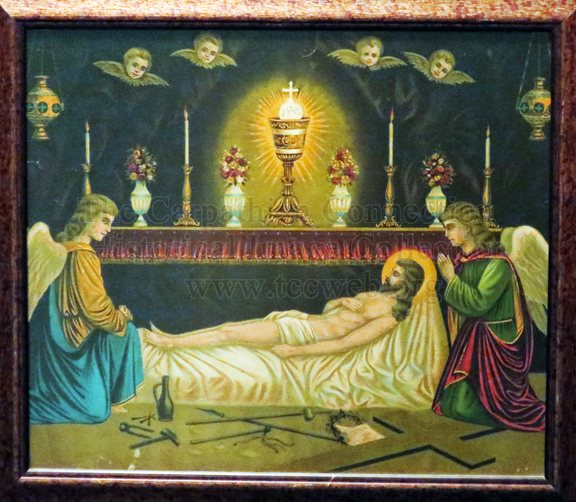 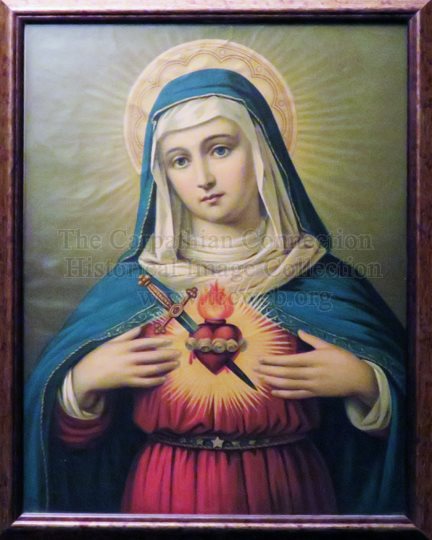
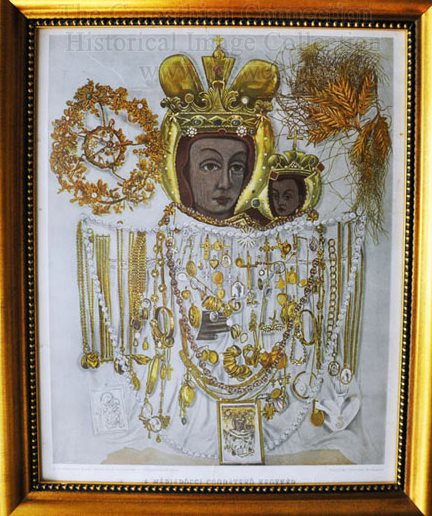
Orthodox
St. John the Baptist Orthodox Church
Alpha, Warren County, New Jersey
One of St. John's early founders was Nicholas Youpa a Rusyn immigrant from the village of Maly Lipnik, Slovakia and a resident of Alpha since the 1890s. Mr. Youpa was also one of the original founders of Saints Peter and Paul Greek Catholic Church in nearby Phillipsburg, New Jersey. In 1916 the First Divine Liturgy was celebrated in the newly formed parish of St. John's by the Rev. Stephen Sipaya. This service was held in a private home that was to become the rectory. In the year 1917 the church building was completed and consecrated by the Bishop of Pittsburgh, Pennsylvania the Right Reverend Stephen. In 1923 the parish entered the Carpatho-Russian Diocese under the Omophorion of Archbishop Adam. In 1942 the parish came under the Omophoroion of Metropolitan Theopilus. The parish cemetery can be located on Fifth Street in Alpha.
Photos Courtesy of Steven M. Osifchin
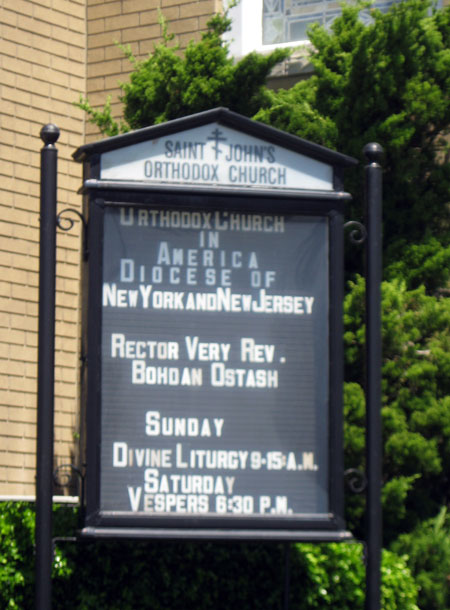
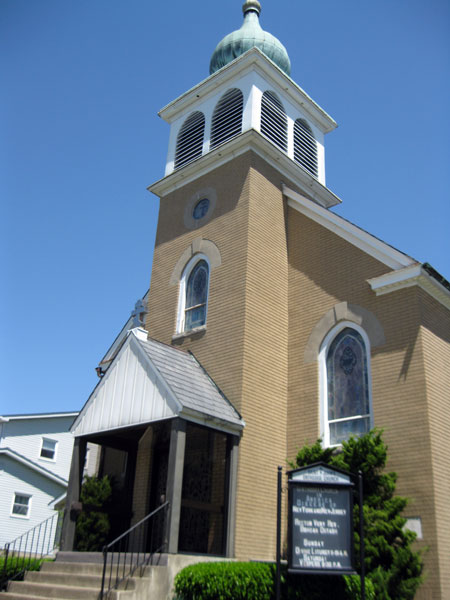
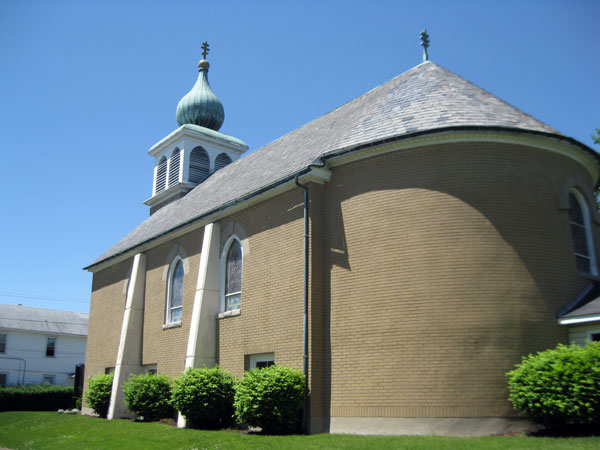
St. John the Baptist Russian Orthodox Church
Passaic, Passaic County, New Jersey
Formerly known as Saint John the Baptist Russian Orthodox Greek Catholic Church
Photos Courtesy of Steven M. Osifchin


History
Original Church Building 1931
Photo Courtesy of Susan Opihory
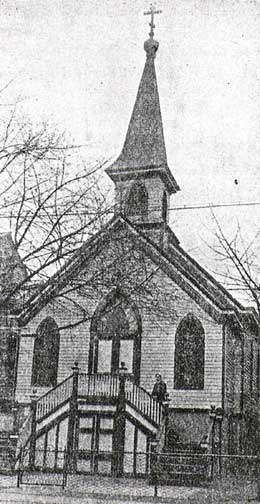
Front of the Church as of 1935 with the addition of Windows in the Choir Loft

Original Altar
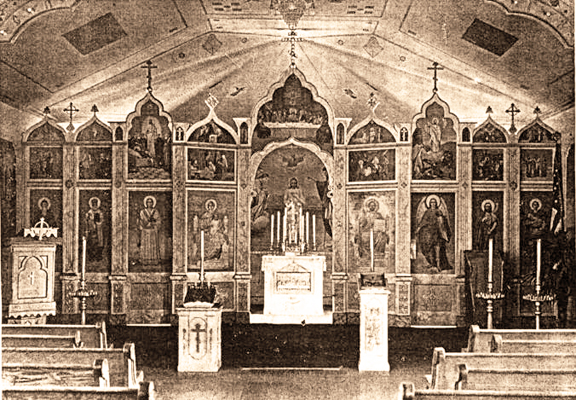
During 1924 a group of individuals gathered at Michael Glita’s Hall to begin planning a new church. At this time, these members were attending Saint Michael’s Greek Catholic church on First Street, Passaic. The majority of these Carpatho-Rusyn founders/members originally came from the villages of Hajtovka, Hrabske, Maly Lipnik, Matysova, Orlov, Starina, Udol/Ujak, and other towns in Eastern Slovakia and the Ukraine. The initial organization committee consisted of John Pida, John Kundrat, John Knapp-Patoray, Andrew Bobey, Michael Nebesnak, John Sadloch, Vasily Olasin, John Moroz and Michael Yulak. The committee designated John Sadloch, Andrew Lyons and Vasily Olasin to meet with Father Kohanik who was stationed at Saint Nicholas church in Whitestone, New York.
Father Kohanik a Carpatho-Rusyn immigrant was born in the village of Becherov which is located in present day Slovakia. He was born in house 108 on August 22, 1880, the son of George Kohanik a village farmer and Anastasia Lescsisin. He was baptized in the Greek Catholic Faith on August 27, 1880 at the Nativity of the Virgin Mary Greek Catholic Church in Becherov by Father Michal Artim. He received his preliminary education in Uzhgorod, Ukraine. He completed his theological education in St. Petersburg, Russia and Simferopol, Ukraine. He married Eugenia Dimytrievna a resident of Crimea, Ukraine on July 27, 1902 in his native village of Becherov. He was ordained into the priesthood on October 13, 1902. On January 20, 1903 Father Kohanik and his wife left for America from Cuxhaven, Germany traveling on the S.S. Auguste Victoria. They arrived at the Port of New York.
Father Kohanik agreed to leave his parish and Whitestone and come to Passaic to head the newly formed parish. After receiving permission from the hierarchy, it was decided to name the new church in honor of Saint John the Baptist. The church however did not yet have a building or parish house. The Rev. Emery Jecusko of the Holy Name Slovak National Catholic Church granted permission to Father Kohanik for services to be held in the temporary Holy Name Slovak National Catholic Church in Paris’ Hall.
In October of 1925 the new parish applied for a Certificate of Incorporation under the name of “The Trustees of St. John Baptist’s Russian Orthodox Greek Catholic Church of Passaic, New Jersey”. The Church officers and Board of Trustees were John Pida, Andrew Babey, Michael Yulak, Vasily Olasin, Michael Chanda, John Sokol, John Kundrat, John Vrable, Theodore Homyak, John Patoray-Knap, John Moroz, Michael Stefanchik, George Dubanjansky, John Komanitsky and Michael Pristash.
Cornerstone of the Original Church

On July 12, 1925, a Vesper service was conducted. In attendance were approximately 130 people and at this service Saint John’s officially began. Members initiated a search for properties in Passaic that would be suitable for a new house of worship. After negotiations were concluded, the members purchased the Swedish Lutheran church which was located at 59 Jackson Street in November, 1925. After renovations, the building was consecrated on October 26, 1926. Later, another property was purchased, The Morris House, which was located at 136 Hamilton Avenue. This house would be utilized as St. John’s Rectory. During this period the church grew and many societies were formed. Some of these organizations were the Friendly Sons’ of St. John’s, a Men’s Club, Senior and Junior Choirs, a Mothers Club-Women’s Society, the Russian Orthodox Brotherhood (Spolok) and a Church School.
The Original Rectory (Photographed in 2014)

Known villages of birth for some of the early church members are as follows:
-
Arendacs – Hajtovka, Slovakia
-
Birchak – Hajtovka, Slovakia
-
Biss – Ujak, Slovakia
-
Chanda – Starina, Slovakia
-
Dopirak – Starina, Slovakia
-
Dornich – Ujak, Slovakia
-
Dornics – Ujak, Slovakia
-
Fabian – Hajtovka, Slovakia
-
Fedor – Ujak, Slovakia
-
Fedush – Hajtovka, Slovakia
-
Fenda – Ujak, Slovakia
-
Fengya – Ujak, Slovakia
-
Geryak – Matysova, Slovakia
-
Haschak – Maly Lipnik, Slovakia
-
Hilko – Starina, Slovakia
-
Hirkala – Legnava, Slovakia
-
Hnat – Ujak, Slovakia
-
Hrinya – Ujak, Slovakia
-
Hudak – Matysova, Slovakia
-
Ilkovics – Matysova, Slovakia
-
Junda – Kruzlov, Slovakia
-
Kollar – Ujak, Slovakia
-
Kovalak – Orlov, Slovakia
-
Kovalycsik – Ujak, Slovakia
-
Knap – Ujak, Slovakia
-
Knapik – Hajtovka, Slovakia
-
Kundrat – Ujak, Slovakia
-
Lazorchak – Maly Lipnik, Slovakia
-
Lesko – Ujak, Slovakia
-
Marko – Starina, Slovakia
-
Miklus – Ujak, Slovakia
-
Mikulik – Ujak, Slovakia
-
Mudrock - Osturna, Slovakia
-
Mucha – Hajtovka, Slovakia
-
Murcko – Hajtovka, Slovakia
-
Olejar - Ujak, Slovakia
-
Onufer - Lukov, Slovakia
-
Patorai – Ujak, Slovakia
-
Petrisin – Ujak, Slovakia
-
Pivovarnik – Svidnik, Slovakia
-
Pristas – Ujak, Slovakia
-
Ruff – Moor (Austro-Hungary)
-
Sadloch – Ujak, Slovakia
-
Sadlock – Ujak, Slovakia
-
Sedlar – Matysova, Slovakia
-
Shedlak – Ujak, Slovakia
-
Sokol – Ujak, Slovakia
-
Soroka – Ujak, Slovakia
-
Stegena – Orlov, Slovakia
-
Super - Orlov, Slovakia
-
Surgent – Ujak, Slovakia
-
Svistak – Maly Lipnik, Slovakia
-
Tulenko - Lukov, Slovakia
-
Vancho – Ujak, Slovakia
-
Vasilik – Maly Lipnik, Slovakia
-
Vrabel – Lenartov, Slovakia
-
Zavatsky – Osturna, Slovakia
In May, 1942 it was decided to purchase a section of land from the non-denominational East Ridgelawn Cemetery in Clifton. This section of land at East Ridgelawn would be designated as a cemetery for St. John’s parishioners. Later, the church constructed a small chapel in this section. It has one gold cupola on top of a brown roof with light brown walls.
As time progressed, it was determined a new church building was required to meet the needs of the parishioners. In September, 1955, the church purchased the Gaston property which is located at the corner of Lexington Avenue and Harrison Street. This is the site of the current church. After planning and negotiations, in June, 1959, construction of the new church began. On September 18, 1960 the cornerstone of the church was blessed. In October, 1960, the church purchased the Bonnar property and a Church School was constructed. Finally, on November 27, 1960 the consecration of the completed Church building was held. Due to the continued expansion of the parish, a new rectory was constructed in June, 1962. As time went on, many updates and improvements were made. One important upgrade was the installation of an air conditioning system for the entire church in June, 1973.
Cornerstone of the New Church
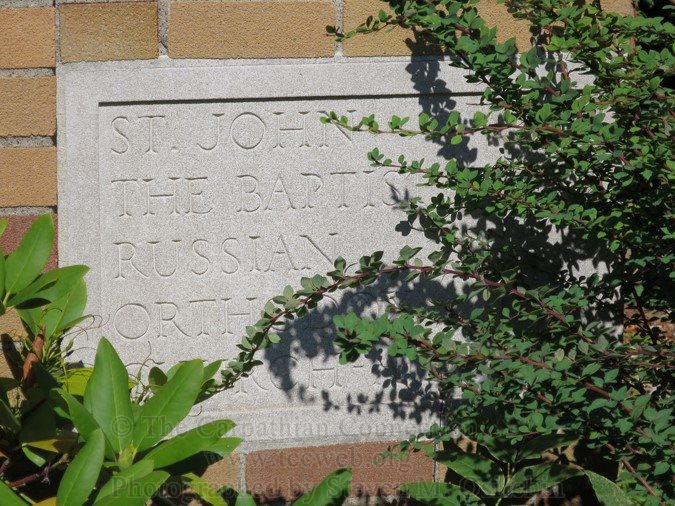
School

The church at Lexington Avenue and Harrison Street was constructed of light red/brown brick facing with two towers. Each tower has one golden cupola. A large oval stained glass window is positioned in the center of the front portion of the church. To the left and right lower portion of the main window are singular elongated stained glass windows. The main entrance has three doors, two main doors and one door on the left and right of the main entrance. The main focal point of the interior is the light brown and gold trimmed iconostasis. The altar area proper is painted blue and this accents the color of the iconostasis. The walls are a light color without painted murals.

Pastors who have served St. John’s throughout the years are: Father Peter Kohanik, 1924-1969, Father dan Donovan, 1969-1981, Father Leonid Kuberski, 1981-1989, Father Dan Pavelchak, 1989-1991, Father James Mason, 1991-1999, Father Nicholas Iuhos, 1999-2001 and Father Christopher Swanson, 2001-2003 and Father Sophrony Royer, 2003 to present.
Please Help Us to Name the Participants in the Following Church Plays
TCC would like to thank Slavomir Gladis for offering us copies of the following photos. The photos were located in the village of Udol in the Slovak Republic. Evidently sent to a friend or relation from a former Udol villager who was residing in the Passaic area.
Contact Us at editors@tccweb.org
(Center) Father Peter G. Kohanik
Back row third from the left is Nicholas Stefanchik
Bottom row seated second from the left is Margaret Elkovics
Second row from the bottom seated to the Right of Fr. Kohanik is Prof. Michael P. Hilko.
Seated three to the Right of Prof. Hilko is his sister Elaine Hilko wife of Nicholas Stefanchik.
(Identified by Paul M. Hilko)
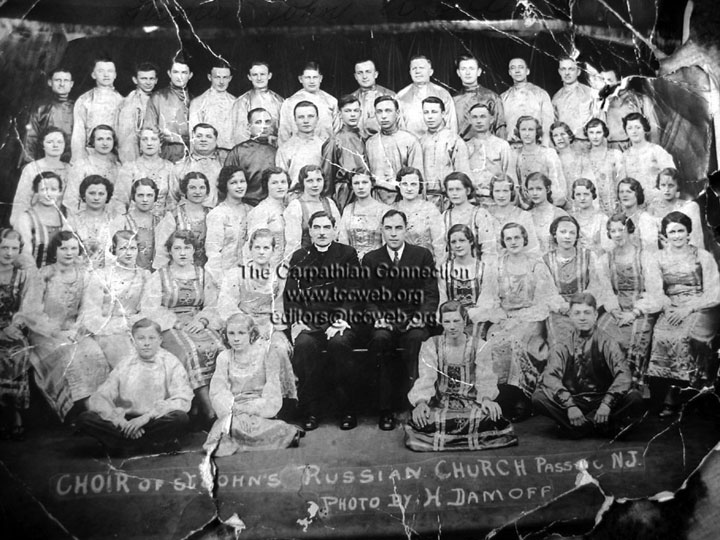
Top Row from Left
John Hrinya 1925-2012; Stephen Nebesnak 1890-1971; Rt. Rev. Archpriest Peter G. Kohanik; Prof. - Choirmaster Michael. P. Hilko
Identified by the members of St. John's "Coffee Hour"
Middle Row from Left
John Hrinya (possibly John Herina b. 1893)
Identified by the members of St. John's "Coffee Hour"
Michael Fechisin, Jr. 1917-1989; Stefan Fenda 1905-1969 (Santa)
Identified by Slavo Gladis & verified by the members of St. John's "Coffee Hour"
Mr. Dolak (Not Sure) and Unknown
Identified by the members of St. John's "Coffee Hour"
Seated
Emil Olasin
Indentified by JoAnn Olasin Veith, Emil's daughter & verified by the members of St. John's "Coffee Hour"
Right is Peter Junda
Identified by Paul M. Hilko & verified by the members of St. John's "Coffee Hour"
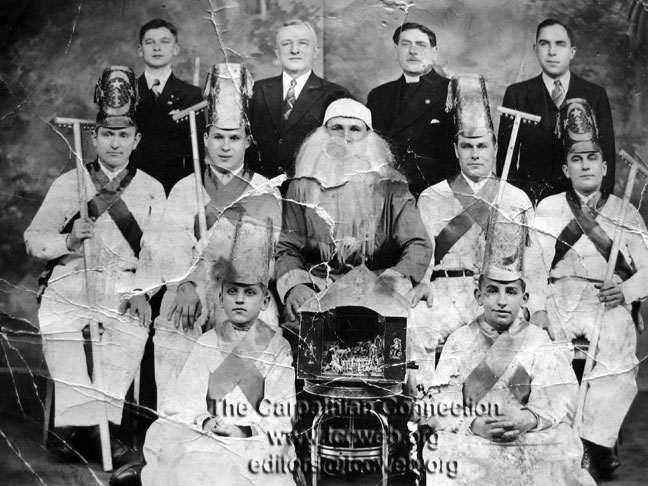
Stefan Fenda 1905-1969 (Third in from Left, white shirt/vest)
(Identified by Slavo Gladis)
Father Peter G. Kohanik (Center)
Seated to the Right of Father Kohanik is Prof. Dickun (suit with vest)
(Identified by Paul M. Hilko)
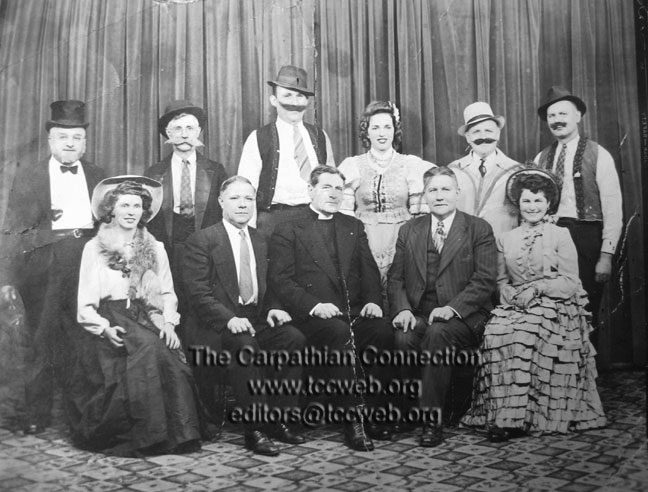
As of 2011 the old church was occupied by the Spanish Evangelical Pentecostal Church
Church Interior and Altar During that Period
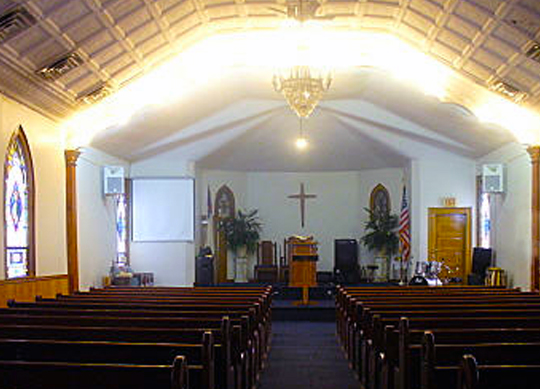
Choir Loft of the Spanish Evangelical Pentecostal Church
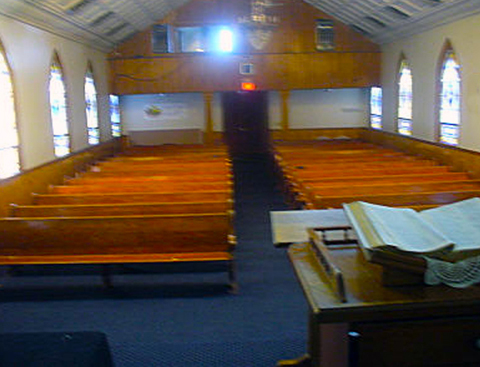
Older Church Pews remain in the Basement 2011
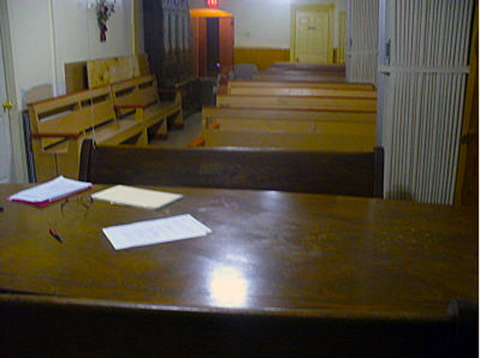
The Original St. John's as of 2014

 
 
Saint John the Baptist Orthodox Church
Perth Amboy, Middlesex County, New Jersey
Immigrants from the Austro-Hungarian Empire settled in various areas of New Jersey. Once such area was Perth Amboy due to the abundance of employment in terra cotta, copper smelting factories and a major coal shipping terminal. These hard working individuals were devout Greek Catholics and wanted a church of their own. Saint John’s was organized in 1897. The first pastor, Father Acacius Kaminsky, made arrangements so they could rent an old church within Perth Amboy. The parish grew at an astonishing rate as did Perth Amboy. Various ethnic neighborhoods took shape and some had names such as Budapest and Dublin. The factories and railroads employed people from various lands such as present day Czechoslovakia, Poland, Hungary, Austria and Italy. As time went on it was apparent that a larger church would be needed as the membership had increased tremendously. The members gave generously and raised the amazing sum of approximately $22,000.00 (which in today’s currency would be approximately $525,000.00!). The church was constructed on the corner of Broad and Division Streets. Father Alexis Novak was assigned to take charge of the growing congregation. Thinking of the future, Father Novak purchased property that was converted to a cemetery so the faithful would have a final resting place. Interior renovations were added such as a magnificent iconostasis which was modeled on the one located at Holy Cross Greek Catholic Church in Uzhorod, Ukraine. Improvements and expansions continued and finally, in 1913 twin towers were added to the exterior of Saint John’s.
During this early period Saint John’s membership numbers gave it the distinction of being the largest Greek Catholic church within the United States. Various clergy served this beautiful church during the years such as Father Bartholomew Tutkovich, Father Peter Kustan and Father Basil Lipetsky. It was during the tenure of Father Basil that a church parochial school was built to ensure the children received a Greek Catholic education. Unfortunately, deep divisions took root in the congregation over various issues. These divisions exploded to a breaking point. Some parishioners demanded to remain Greek Catholics. Others wanted to change their ancestral religion and demanded to become part of the newly former Carpatho-Russian Orthodox Diocese located in Johnstown, Pennsylvania. This diocese was founded in 1938 and approximately 37 Greek Catholic parishes changed jurisdictions and were placed under the Ecumenical Patriarchate of Constantinople. These were difficult days for the parish and it endured a long legal dispute within the court system. In 1954, more renovations were required for the church and associated buildings. Brand new stained glass windows were added, the exterior of the church was brick faced and in total, the parishioners donated $150,000.00 to pay all the necessary costs.
During the 1950’s Father Stephen Sedor was appointed pastor and he would have a long and very productive tenure. Under his guidance a Sunday school was established, a new rectory was constructed, new parking lots were added and a modern kitchen was installed in the school hall. Throughout the years other pastors in conjunction with the parishioners made additions to the church. In 1994 the church basement was modernized and in 1995 due to structural problems, a new ceiling was installed. In 1997 the church celebrated their 100th anniversary. The parishioners and clergy gathered to give thanks for their house of worship and to remember all who had gone before them. However, this was not the end of additions to Saint John’s. During 2005, the iconographer Mr. Dennis Bell was contracted to paint various icons for the interior of the church. In 2010, the steeple bells were fully restored. These bells once more ring out as they did in the beginning with melodic sounds that summon the faithful to worship. Saint John’s offers many events and activities for parishioners and visitors. Some are a social club, Altar Society and a Senior Citizens Club. The Church offers a Divine Liturgy each Sunday at 9 a.m. and is well attended. Saint John’s has come far since its original origins in 1897. The current parishioners are proud of their church and look forward to more years where their children and grandchildren will continue to worship.
SS. Peter & Paul’s Russian Orthodox Cathedral
Passaic, Passaic County, New Jersey
Photos Courtesy of Steven M. Osifchin

History

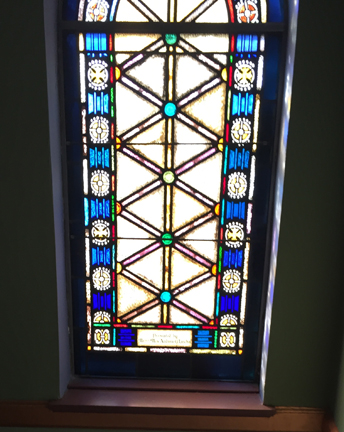 

Saints Peter and Paul Russian Orthodox Greek Catholic Church in Passaic, New Jersey was composed of individuals who immigrated to the United States from former areas within the Austro-Hungarian Empire. Many members came from the village of Vysni Orlik which is located in present day Slovakia. Others hailed from villages within the Galicia region which today is known as Southern Poland. Arriving in the City of Passaic, these immigrants desired to worship God as they had for centuries in their homeland. Originally, members attended Saint Michael’s Greek Catholic Church on First Street. Later, a segment of the membership wished to start another parish. A meeting was held on March 24, 1902. The decision was made to leave Saint Michael’s and form a new church. The new church was named Saints Peter and Paul Greek Catholic Church. The first elected trustees for Saints Peter and Paul were: Joseph Timko, Joseph Olcholvsky, Peter Gladis, Michael Dudaschik, Peter and George Kmetz, Andrew Sidor, John Kiselica, John Kopcho, Michael Buriak, Andrew Cuper, Michael Mandiak, George Pirich, Joseph Tkach and Joseph Hudak. The members agreed to purchase the Presbyterian Church and adjoining property which is the site of the present Cathedral. The members petitioned Father Basil A. Volosin, an ordained priest from Hungary, to become pastor of the newly formed congregation. Father Volosin left Pennsylvania and arrived in Passaic in 1902. The parishioners made alterations to the Presbyterian Church structure and purchased a set of bells. The church was dedicated on July 13, 1902. From 1902 to 1905 the church was not attached to any jurisdiction. However, in 1905, the church formally submitted to the jurisdiction of the Roman Catholic Bishop of Newark, Bishop John Joseph O’Connor. Upon this acceptance, Father Basil Volosin left the parish and a new pastor, Father Eugene Homicsko was assigned to Saints Peter and Paul. Father Homicsko remained at the church until his departure in February of 1909.
The Original SS Peter & Paul Greek Catholic Church in 1902
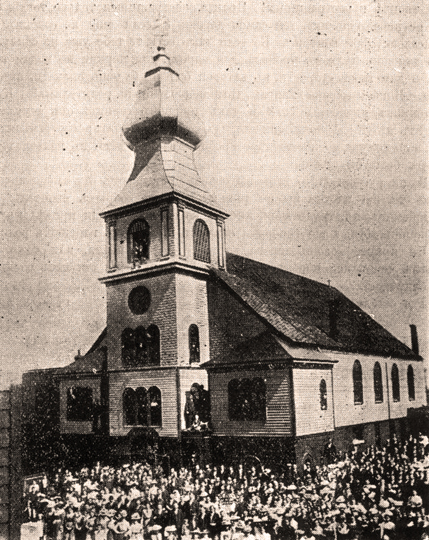
Etching taken from the St. Nicholas Bell in the original church. "St. Peter & Paul Geek Catholic Church. Rev. Basil Volosin, Pastor. Passaic, N.J. A.D. 1902"
.JPG)
Father Homicsko was followed by Father John Krochmalny. Father Krochmalny served as pastor of the church until 1910. During this period the church decided to change jurisdictions and join the Russian Orthodox Church. The Reverend Alexander A. Hotovitzky was installed as pastor on February 21, 1910. A meeting was held and the decision to change jurisdictions was finalized. Resolutions of acceptance were approved by Archbishop Platon and Saints Peter and Paul officially became part of the Russian Orthodox Church on March 6, 1910.
Father Elias Klopotovsky was appointed pastor in April 1910. The parish grew and by 1910 it became necessary to enlarge the church. Father Klopotovsky and the trustees of the church contacted Archbishop Alexander Nemolovosky of St. Nicholas' Cathedral of New York City for financial assistance. Archbishop Nemolovosky informed the church that the Czar of Russia agreed to contribute the sum of $40,000 of the total construction costs which were estimated at that time to be in excess of $125, 000. The new edifice was constructed on the corner of Third and Monroe Streets.


The new church was consecrated by Archbishop Platon in 1911. Father Joseph Stephanko replaced Father Klopotovsky in August 1913. At that time many auxiliary organizations were formed. Some of these were: The Brotherhood of Saints Peter and Paul, the Saint Vladimir Brotherhood, the Women’s Altar Society and the Saint Mary Russian Orthodox Women’s Society. In April 1922 Father Michael Sotak succeeded Father Stephanko as pastor. He served the church well until March 16, 1930 when Father Joseph A. Havriliak became pastor.

Under Father Joseph’s guidance the parish experienced many new additions and saw membership numbers soar. The interior was completely remodeled. A new altar and iconostasis were installed. Pews were added, stained glass windows replaced plain glass windows which were over 25 years old and the bells were electrified. Father Joseph, a patriotic American, assisted many of his members with the application process leading to American citizenship. He also promoted the use of English for various services so the youth of the parish could participate more fully. Also, during the terrible days of the Great Depression, Father Joseph worked tirelessly to find jobs for the members of the Cathedral who were unemployed. After renovations were completed, the interior of the Cathedral was blessed in May 1943 with a Pontifical Divine Liturgy co-celebrated by the highest Prelates of the Jurisdictions in America. Metropolitan Benjamin, Eparch of the Russian Patriarch in the Americas, Archbishop Athanogoras, Primate of the Greek Orthodox Church in the Americas (who later became the Ecumenical Patriarch) and Metropolitan Orestes P. Chornock of the American Carpatho-Russian Orthodox Diocese of Johnstown, Pennsylvania. In 1952 the 50th Anniversary of the parish was celebrated. Over 500 parishioners and friends of the church attended an anniversary banquet at the church auditorium. Father Joseph was very fortunate to be assisted by his brother, Demetro Havriliak, a gifted Cantor/Choir Director. “Metro” as he was affectionately known within the choir, assisted Father Joseph for years singing responses for all services and directing the choir. A humble man of God given natural talent, he excelled in the art of singing Prostopinije (Plainchant) which is a traditional form of music in the Carpathian regions of Slovakia and Poland.
In 1953 Father Joseph was honored by his Holiness Patriarch Alexis with the honor of a miter. In May 1954 the status of the church was changed from that of church to Cathedral (Katholikon) by His Holiness Patriarch Alexis. Archbishop Dyonisy read the proclamation during a Pontifical Divine Liturgy. Saint Peter and Paul’s now held the same title designation as Saint Nicholas Russian Orthodox Cathedral on East 97th Street in New York City.
In 1958 a home on Market Street in Saddle Brook was purchased for $1.00 and moved to the parish cemetery. The first floor was converted to a chapel. The cemetery chapel was dedicated in 1959 by Father Joseph and his assistants, Father Nicholas Brodionoy and Father Anthony Renye.
Father Joseph was instrumental in purchasing property on Third and Fourth Streets. This property was utilized for a parking lot as more members had cars than in previous years. Also, property was utilized for the building of a new auditorium and school. A banquet was held at the Passaic Armory. Over one thousand people attended to raise money for this project. A Cultural Center was constructed on the side of the cathedral. The center included classrooms for Sunday school, a lounge and a large auditorium. A new church office was also constructed at this time. In 1963 the cultural center was dedicated with Metropolitan John, Archbishop Dositheus and Archbishop Panteliemon co-celebrating the Pontifical Divine Liturgy. A banquet followed the blessing of the Center.

On October 28, 1969 after 40 years of dedicated service, Father Joseph passed away. His son, Father Dennis, who served as assistant priest for the past ten years, became the new pastor. Father Dennis oversaw the remodeling of the Cathedral. Projects such as painting, installation of rugs and the construction of a new rectory were completed. Also, new window frames were added to the Cathedral and the parking lot was expanded. The main steeple of the cathedral was refurbished with copper and a new cross was installed. Due to the height, a helicopter needed to be utilized to complete this project.
Father Dennis was instrumental in organizing the Federated Russian Orthodox Chapter #30 and also a Junior Chapter. The Junior Chapter of this organization had a basketball team that won a number of awards. To help the Sunday School, the P.P.T.A. took a very active role by organizing trips and the sponsoring of Christmas and Halloween parties. Many members also assisted in the church kitchen for various functions held at the cultural center. All funds received for these functions were donated back to the Cathedral. Always looking for ways to meet the needs of his spiritual children, Father Dennis organized many bus rides. A favorite trip was the annual bus trip to Seaside Heights, New Jersey.
In March 1970, Father Dennis was elevated to the title of Very Reverend Archpriest by Metropolitan Nikodim of Lenningrad and Novgorod. On Holy Saturday 1973 he was given the jeweled cross and named Dean of Eastern States by Bishop Makary, then Vicar-Bishop. On Holy Saturday 1976, Father Dennis was once again honored with the miter. He was given the title Right Reverend by decree of His Holiness Patriarch Pimen for his zealous work for the church. He was also a member of the Bishops Council. In 1982 Father Dennis was awarded a second Patriarchal Cross and in 1989, he was awarded a third Patriarchal Cross. In 1989 after 30 years of devoted service, Father Dennis retired. Father Alexander Krenicki, a priest who assisted Father Dennis, was installed as pastor of the Cathedral. In 1990 Father Eugene Carroll was called upon to serve temporarily due to the illness of Father Alexander. Father Eugene began his service to the Cathedral as a member of the choir. Later he was tonsured a reader and ordained to the Diaconate in 1980. He served the Cathedral for three years as Deacon and also as Choir Director. Father Eugene Carroll, along with past Cantor/Choir Director Demetro Havriliak, were thoroughly experienced and talented Choir Directors who served at the Cathedral. Under Father Eugene’s leadership, the Choir flourished. A genuine artist, Father Eugene would enter the Cathedral when no services were scheduled to practice signing various services and hymns. Father Eugene devoted himself to striving for perfection in God’s House. His unique and beautifully majestic voice adorned the Cathedral like a jewel. Father Eugene Carroll was ordained to the priesthood in 1984 and was assigned as pastor to St. George the Great Martyr Russian Orthodox Church in Bayside, New York.
 
Father Eugene served as interim pastor for Saints Peter and Paul Cathedral for three months. After this period of time, he was installed permanently. To assist Father Eugene with the spiritual care of the members, Father Gregory Onisko and Father Sergius Kosich were also assigned to the Cathedral. Father Eugene oversaw many improvements and worked diligently to accomplish all tasks set before him. Under his pastorate, the property at 197 Fourth Street was purchased. He also took initial steps for a massive remodeling project. The Cathedral had not been maintained on a regular basis for a long period of time. The Cathedral required extensive interior and exterior renovations. These renovations also included a new roof for the entire church. The renovation estimate costs for these projects were staggering even for that time period. Father Eugene, always placing his trust in God, worked constantly to make sure the restoration project would be implemented. Sadly, Father Eugene became ill during this phase of the Cathedral’s history. Father Gregory Onisko assisted and took over many duties to help Father Eugene during his illness which later, turned serious. It was with profound sadness the parish learned the news on November 14, 1995 that Father Eugene had passed away.
Since the beginning, members worked along with their pastors for the church. God brought the Cathedral through good and trying times right into the 21st Century. The Cathedral has a vibrant past which witnessed many changes and transformations through the years. The love, devotion and sacrifices of the parishioners of Saints Peter and Paul Cathedral have made it an inspiring house of worship. The Cathedral looks to the future when a new generation will continue the work begun in 1902.
Father Basil A. Volosin
Photo Courtesy of Fr. Tamás Véghseő
Fr. Véghseő is a Greek Catholic Priest of the Eparchy of Hajdúdorog (Hungary), Church historian and Rector of the St Athanasis Greek Catholic Theological Institute in Nyíregyháza, Hungary.
Father Volosin is on the Left and Unknown Greek Catholic Priest
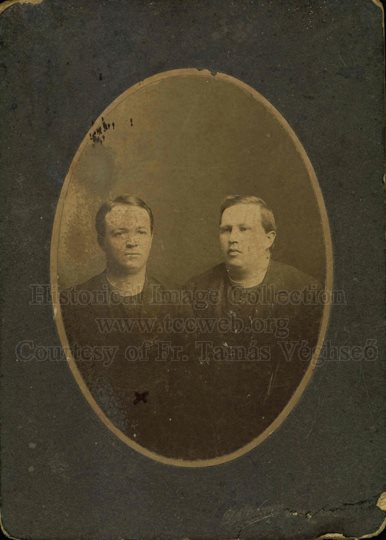
Studies: Ungvár (Uzhorod), 1882-1886
Eparchial Archivist in Ungvár (1887-1888), Parish Administrator in Kisszolyva (1888-1894)
In the USA: 1895-1910
1910: In Hungary again:
Parish Priest in Sárközújlak 1910-1913,
Parish Priest in Buj 1913-1920.
Dean of the Nyíregyháza District (1913-1920).
1920 Returned in the USA
Basil A. Volosin was born in Szinever, former Maramaros district, present day Ukraine, in 1863. Basil came from a long line of Greek Catholic priestly families. Basil was the son of Anthony Volosin and Hermina Kovordany. Prior to ordination, he married Sofia Danilovics (†1949). Pani Sofia was born in Csornoholova, former Ung district, present day Ukraine, in 1870. Father Basil and Pani Sophia had three daughters, Amelia (*1894), Helen (*1897) and Irene (*1899) who were born in the town of Kisszolyva. Today the town is known as Skotars’ke and is located within the Ukrainian Catholic region of Western Ukraine. Father Basil and Pani Sophia’s children born in America were Elizabeth (*1901), born in Mahanoy City, Schuylkill county, Pennsylvania, Magda (*1903, wife of Fr Joseph Maczkó), Mackinaw City, Cheboygan County, Michigan and Olga (*1905) who was born in Passaic, Passaic County, New Jersey.
Father Basil was a missionary priest of the Mukachevo (present day Ukraine) diocese. During the turn of the century, thousands of Greek Catholics were immigrating to America and priests were needed to care for their spiritual needs. In 1898, a petition was sent by the Greek Catholic clergy of the United States to the Austro-Hungarian government. A number of the thirty-three men who signed the petition including Father Basil Volosin, were among the first Greek Catholic priests to arrive in America. The petition requested assistance from the Austro-Hungarian government to aide them in the construction of churches. A copy of the petition was also sent to Pope Leo XIII. At this time Father Basil was the parish priest of St. Mary’s Greek Catholic Church in Mahanoy City, Pennsylvania. Father Basil served St. Mary’s for a number of years. In 1902, he received a direct invitation from a segment of Greek Catholic men and women residing in the City of Passaic, New Jersey to be the priest for a newly founded church. These members had previously attended Saint Michael’s Greek Catholic Church two blocks away. However, due to irreconcilable differences in dialect and traditions, they chose to start a new Greek Catholic Church.
After making arrangements, Father Basil left Mahanoy City and began his tenure at Saints Peter and Paul Greek Catholic Church on Third Street, Passaic during April, 1902. Father Basil worked relentlessly with his congregation. Parishioners were very generous and donated funding to remodel the Presbyterian Church that had been purchased. The parishioners sacrificed and paid for a new set of bells, interior decorations, required liturgical items and the installation of an altar. Many sacrifices were made to construct this church for worship in the centuries old faith of their ancestors. The confidence of these members and their pastor inspired everyone to make this dream a reality. Father Basil assisted in every way possible to complete the work quickly. Finally, on July 13, 1902 the church was ready for full-time worship. Father Basil along with Roman and Greek Catholic prelates and clergy including Father Cornelius Laurisin (Diocese of Mukachevo) of Saint Michael’s Greek Catholic Church in Shenandoah, Pennsylvania and Father Anthony Kecskes (Diocese of Presov) of Saint Michael’s Hungarian Greek Catholic church in Perth Amboy, New Jersey, solemnly dedicated the new church. This was the first church Father Basil had managed “from the ground up” and in conjunction with his committed parishioners; the City of Passaic now had a second Greek Catholic church. It is to the credit of Father Basil and his congregation that Saints Peter and Paul still exists today. The church would never have begun without their hard work, dedication and benevolence.
Father Basil continued to serve Saints Peter and Paul Greek Catholic Church in Passaic until 1905. At this time the membership voluntarily transferred the church to the jurisdiction of the Roman Catholic Bishop of Newark, Most Reverend John J. O’Connor, D.D. Father Basil was then assigned to assist Father Acacius Kaminsky, pastor of Saint Mary’s Greek Catholic Church in Kingston, Pennsylvania. St Mary’s was expanding rapidly and Father Acacius required assistance to serve his large congregation. During 1906 Father Basil was called upon to relocate back to New Jersey and serve Assumption of the Virgin Mary Greek Catholic Church in Trenton. Father Basil would serve this growing parish until 1908. Father Basil began a practice at Saint Mary’s that was taken up by his successor, Father Anthony Laurisin. Father Basil worked to purchase property and have two family brick homes constructed to be sold to members of his parish at cost. In total, five blocks were purchased and eventually held a majority of residents who attended Saint Mary’s Greek Catholic Church in Trenton. During his priestly service, Father Basil would serve parishes throughout the United States including Holy Trinity Greek Catholic Church, New Britain, Connecticut, St. Mary’s in Winber, Pennsylvania, St. Nicholas of Myrna in Yonkers, New York and Saint Gregory the Theologian Greek Catholic Church in Lakewood, Ohio. Father Basil was installed as pastor of Saint Gregory’s in June of 1922. During his tenure a new enlarged brick church was constructed in place of the original wooden church which became too small for the growing parish. The church was dedicated on August 8, 1926 by His Excellency, Bishop Basil Takach, D.D., who was the Bishop of the Greek Catholic Pittsburgh Exarchate. During the end of 1927, Father Basil left Saint Gregory’s after faithfully serving this parish for five years.
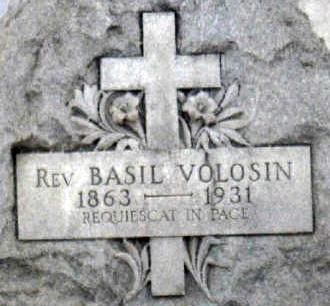 At the end of his life, Father Basil’s health deteriorated. He was admitted to St. Alexis’ Catholic hospital in Cleveland, Ohio on March 16, 1931. He condition deteriorated and he died on Wednesday, March 18, 1931. He was approximately 67 years old. The funeral mass for Father Basil Volosin was held at Saint Michael’s Greek Catholic Magyar Church in Lorain, Ohio. Reverend Father Thomas Szabo, Dean of the Cleveland District and other members of the clergy in Lorain officiated. He was buried in Calvary Roman Catholic Cemetery in Lorain, Ohio. Later, his family would be interred with him in the family plots. Buried with Father Basil are his wife Pani Sophia (d.1949), daughters Elizabeth (d.1964), Amellia (d.1969) and Helen (d.1973). Father Basil Volosin served during the infancy of the Greek (Byzantine) Catholic Church in America and assisted in its expansion. Today, due to the devotion of priests like Father Basil, the Byzantine Catholic Church in America continues to grow. The church is strong, vibrant and has remained constant and faithful to its centuries old traditions while welcoming all ethnic backgrounds within American society. At the end of his life, Father Basil’s health deteriorated. He was admitted to St. Alexis’ Catholic hospital in Cleveland, Ohio on March 16, 1931. He condition deteriorated and he died on Wednesday, March 18, 1931. He was approximately 67 years old. The funeral mass for Father Basil Volosin was held at Saint Michael’s Greek Catholic Magyar Church in Lorain, Ohio. Reverend Father Thomas Szabo, Dean of the Cleveland District and other members of the clergy in Lorain officiated. He was buried in Calvary Roman Catholic Cemetery in Lorain, Ohio. Later, his family would be interred with him in the family plots. Buried with Father Basil are his wife Pani Sophia (d.1949), daughters Elizabeth (d.1964), Amellia (d.1969) and Helen (d.1973). Father Basil Volosin served during the infancy of the Greek (Byzantine) Catholic Church in America and assisted in its expansion. Today, due to the devotion of priests like Father Basil, the Byzantine Catholic Church in America continues to grow. The church is strong, vibrant and has remained constant and faithful to its centuries old traditions while welcoming all ethnic backgrounds within American society.
Father Eugene Homicsko
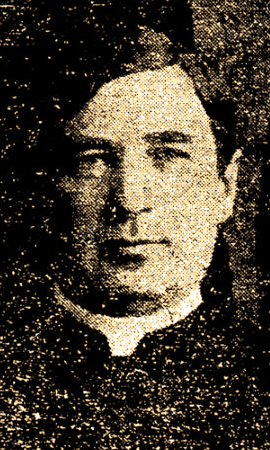 Eugene Homicsko was born approximately 1869 in the former Austro-Hungarian Empire. He studied for the Greek Catholic priesthood and prior to his ordination he married the former Elizabeth Miksievicz of *Bilke, Austro-Hungary. Soon after the birth of their first child the couple immigrated to America. Father Eugene and Pani Elizabeth were blessed with three children, Magdalene (1897- 1983); Olga (1902-1975); and Nicholas, (1911-2000). Magdalene became the wife of John Louis Darabanth. Olga became a librarian and later married Julius Schey. Nicholas attended Georgetown University and graduated with a degree in dental surgery from a dental college in Philadelphia, Pennsylvania. He later joined the armed services and became a Commanding Officer of a United States Navy Submarine during World War II. Nicholas was the husband of Margaret Elizabeth a native of Munich, Germany. Eugene Homicsko was born approximately 1869 in the former Austro-Hungarian Empire. He studied for the Greek Catholic priesthood and prior to his ordination he married the former Elizabeth Miksievicz of *Bilke, Austro-Hungary. Soon after the birth of their first child the couple immigrated to America. Father Eugene and Pani Elizabeth were blessed with three children, Magdalene (1897- 1983); Olga (1902-1975); and Nicholas, (1911-2000). Magdalene became the wife of John Louis Darabanth. Olga became a librarian and later married Julius Schey. Nicholas attended Georgetown University and graduated with a degree in dental surgery from a dental college in Philadelphia, Pennsylvania. He later joined the armed services and became a Commanding Officer of a United States Navy Submarine during World War II. Nicholas was the husband of Margaret Elizabeth a native of Munich, Germany.
Father Homicsko was appointed by Roman Catholic Bishop John Joseph O’Conner of Newark in 1905 to take charge of Saints Peter and Paul Greek Catholic Church in Passaic, New Jersey. This was a young parish that had been lead by Father Basil Volosin since its inception in 1902. Father Eugene along with the financial assistance of dedicated parishioners continued the expansion that Father Volosin began. Four years into Father Eugene’s tenure an internal turmoil regarding property rights arose. Father Eugene worked diligently to preserve the historical and spiritual ties of his parishioners to their beloved Greek Catholic faith. However, his efforts failed and it was decided that the church would transfer from the ancestral Greek Catholic faith to Orthodoxy. A requirement for Father Eugene to remain with his flock was that he had to convert to the Orthodox faith. As a matter of conscience Father Eugene refused to comply with this request. After much persuasion this matter remained unresolved. On February of 1909 he was forced to give up his leadership of the church. On February 21, 1910 the church officially changed jurisdictions.
Father Eugene served various churches from 1909 until 1912. In 1912 he was appointed the first resident pastor of the newly constructed Saint Mary’s Greek Catholic Church in New York City where he served for two years. In 1915, Father Eugene was appointed as resident pastor of Assumption of the Virgin Mary (Saint Mary’s) Greek Catholic Church in Trenton, New Jersey. Since its inception St. Mary’s had grown rapidly consisting of 700 families by the year 1915. The former church building could no longer support the growing flock. The faithful raised the funds for a new granite church that was blessed and dedicated by Bishop Soter Stephen Ortynsky with Father Eugene assisting as a concelebrant. In the years that followed under Father Eugene’s leadership the parish prospered. Father Eugene was firm in the conviction his parishioners’ children should have access to education in their ancestral faith. He implemented plans to construct a Greek Catholic parochial school which would be the first parochial school constructed within the Greek Catholic Apostolic Exarchate. On August 15, 1920 the school was constructed and stands to this day. In that same year Father Eugene went forward with plans for the construction of a two story rectory on Adeline Street. The parochial school was blessed and dedicated on November 27, 1922 by His Excellency, Metropolitan Septycki, D.D., who at that time was visiting the United States from Europe. Father Eugene requested the Sisters of Saint Basil the Great in Uniontown, Pennsylvania staff the school as teachers. Construction also began on a convent for the Sisters. Father Eugene worked intensely to ensure his church expanded and that every need, spiritual and temporal, of his parishioners were met. Due to his hard work, Saint Mary’s in Trenton became a prominent Greek Catholic church on the East Coast. Under Father Eugene’s personal supervision he began and trained a professional choir. This choir was recognized as a prominent choir and had no equal on the East Coast at that time. Under his direction the choir travelled and performed concerts in various states and had a reputation as one of the finest choirs on the East Coast.
By 1928 after years of hard work and intense devotion to his parishioners, Father Eugene’s health began to deteriorate. Realizing he could no longer attend to the duties of such a large congregation, he offered his resignation to the Ruthenian Greek Catholic Bishop, Bishop Basil Takach. It was decided that Father Eugene would take a much needed respite and then be transferred to the more manageable parish of Saints Peter and Paul Greek Catholic Church in Beaver Meadows, Pennsylvania.
Prior to Father Eugene’s departure, the choir of Saint Mary’s gave him a large farewell banquet in the parochial school auditorium to recognize his achievements. The toastmaster at the banquet was Professor John Nemesh. Others who spoke in praise of Father Eugene were Michael Nemchik, Joseph Remenicky, Michael Tursncik, Joseph Kusnir, John Ceremsak, George Slaboda and Mrs. Elizabeth Bacsik. Father Eugene was presented with a gift and students of the parochial school greeted him and offered their thanks and well wishes.
Father Eugene’s service to Saints Peter and Paul Greek Catholic Church would be brief. His health continued to decline and on January 20, 1932 he died as the result of a stroke in Hazelton, Pennsylvania. Father Eugene’s wife Pani Elizabeth died a few years later on May 19, 1936 in Trenton, New Jersey.
Father Eugene Homicsko worked to ensure the Greek Catholic Church in America expanded and flourished. It is a testament to all his faith and dedication that Greek (Byzantine) Catholic churches he administered are still in existence today.
* Bilke, Austro-Hungary later became part of Slovakia. Today, this town is called Bilky and is located in present day Ukraine.
|
|
|
